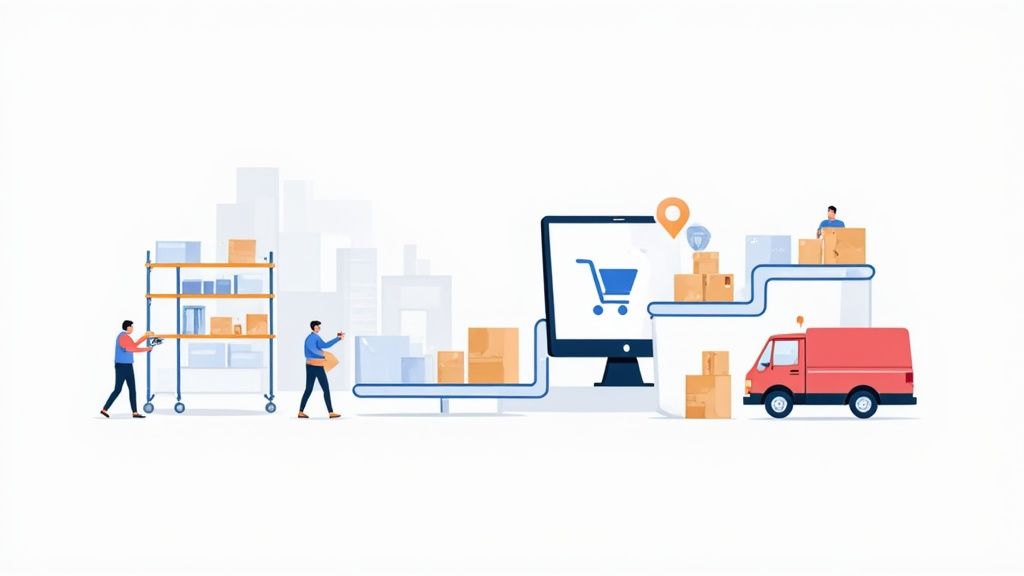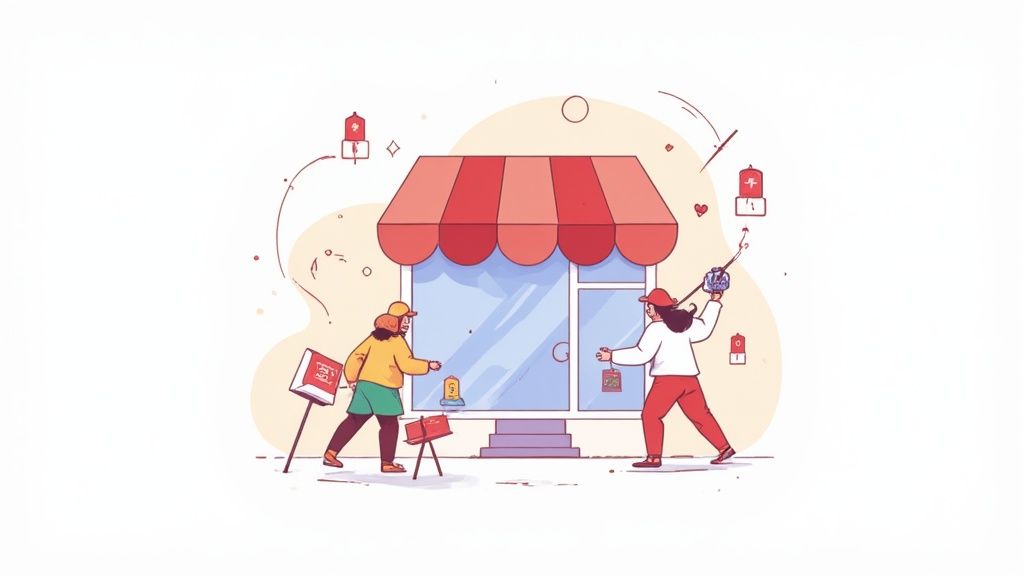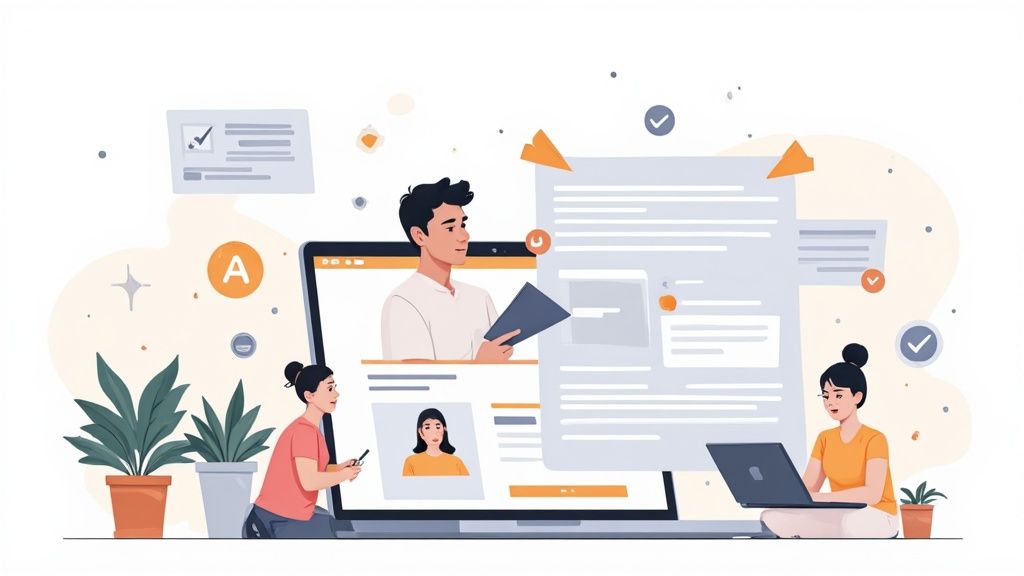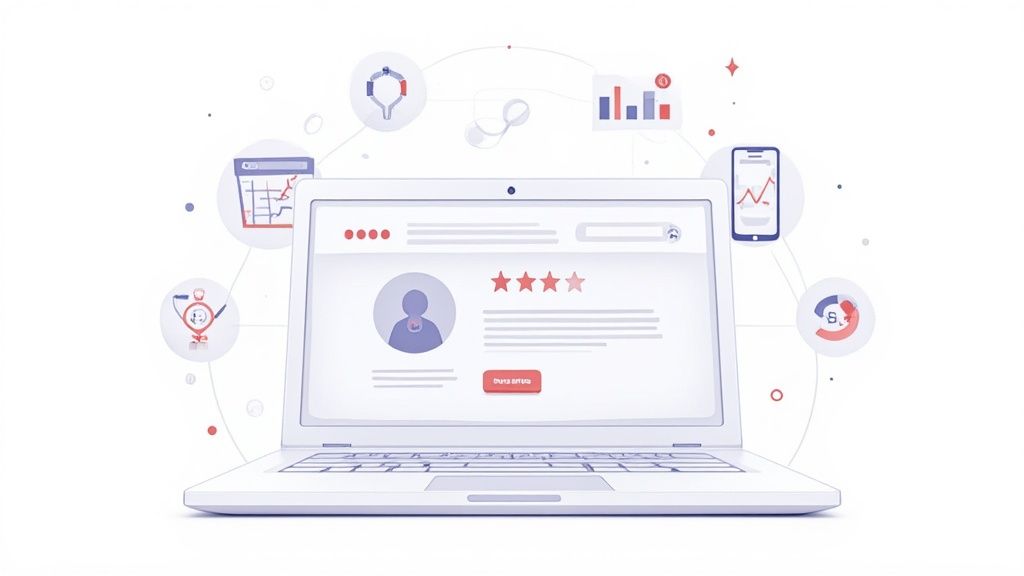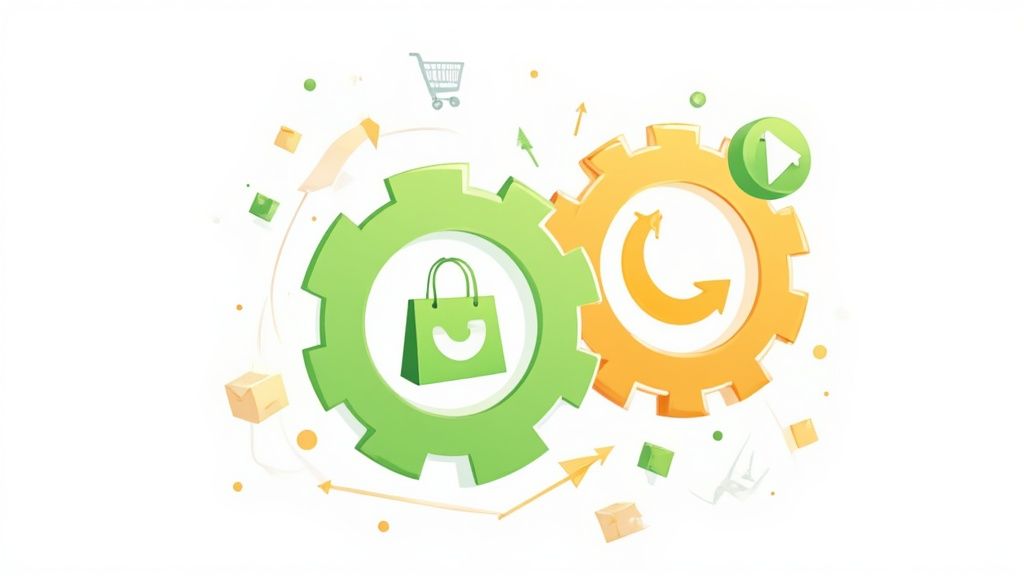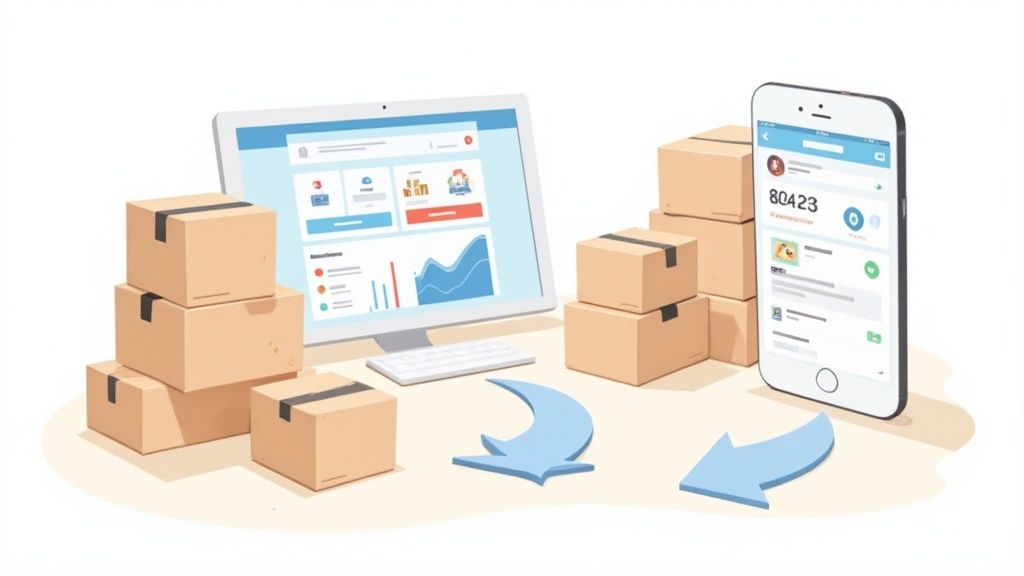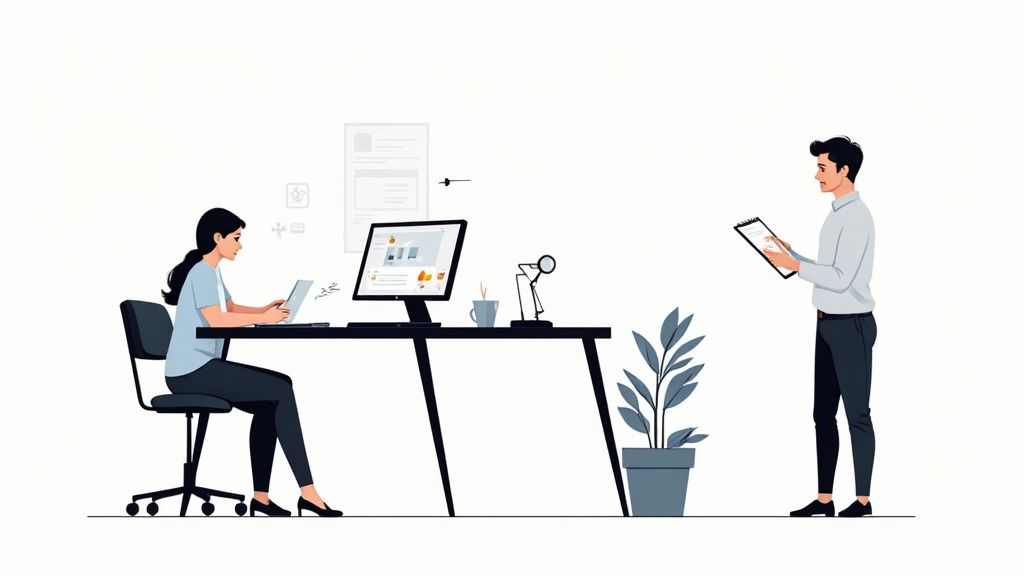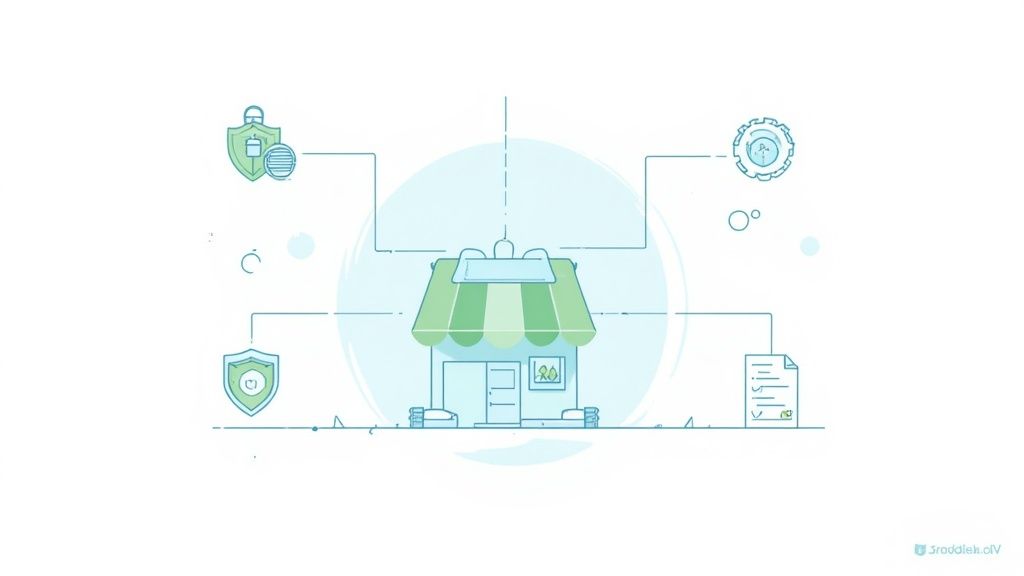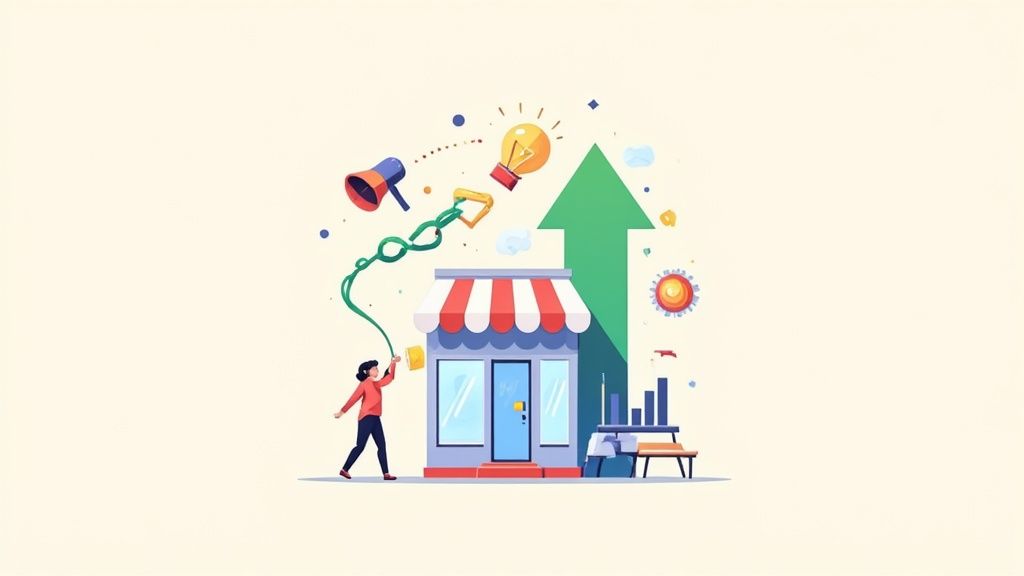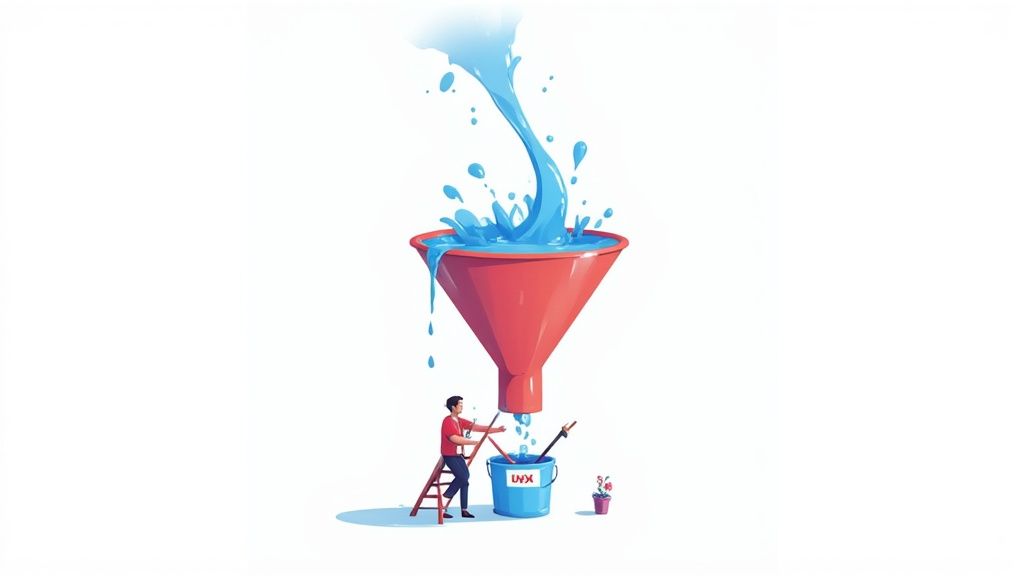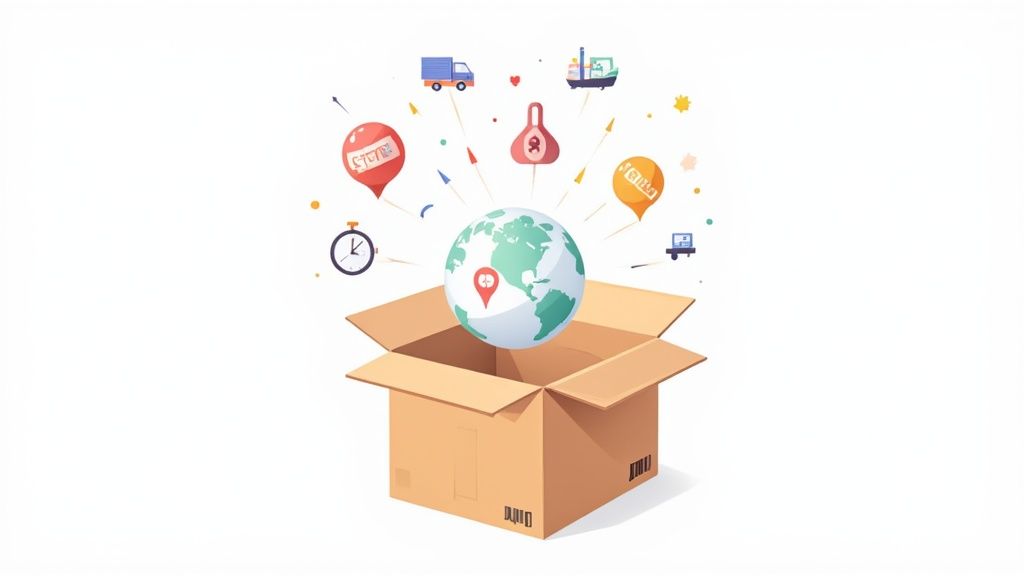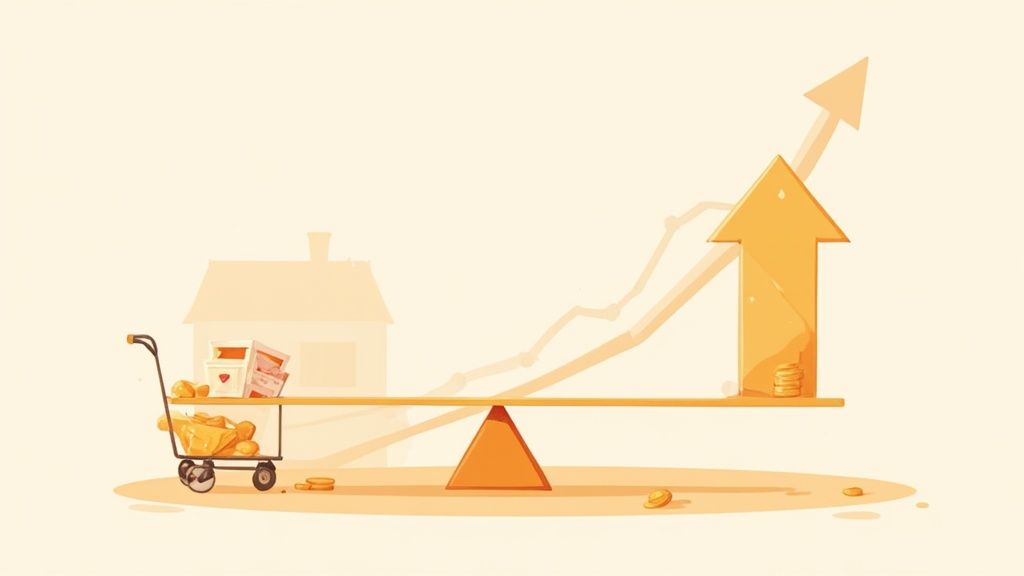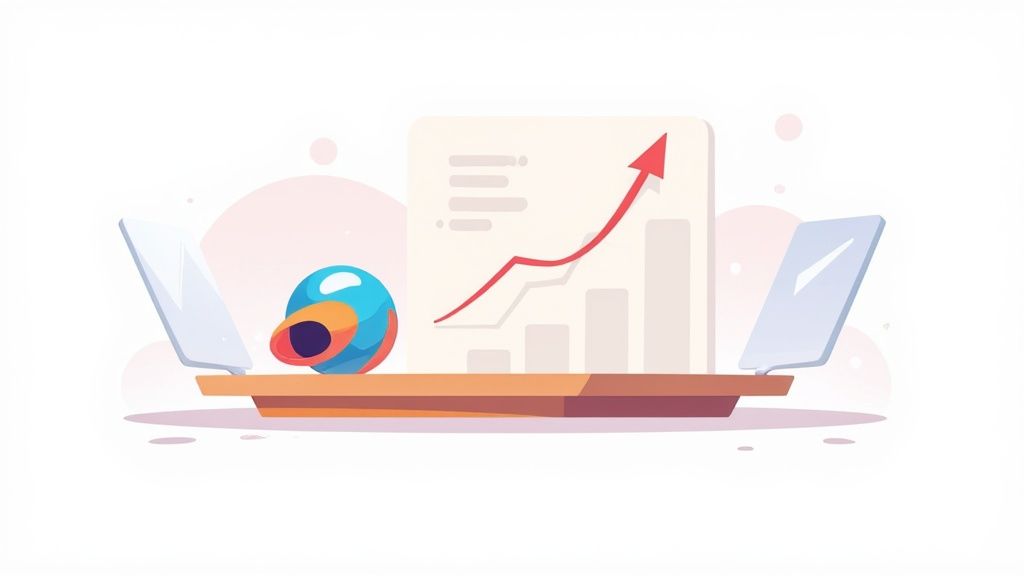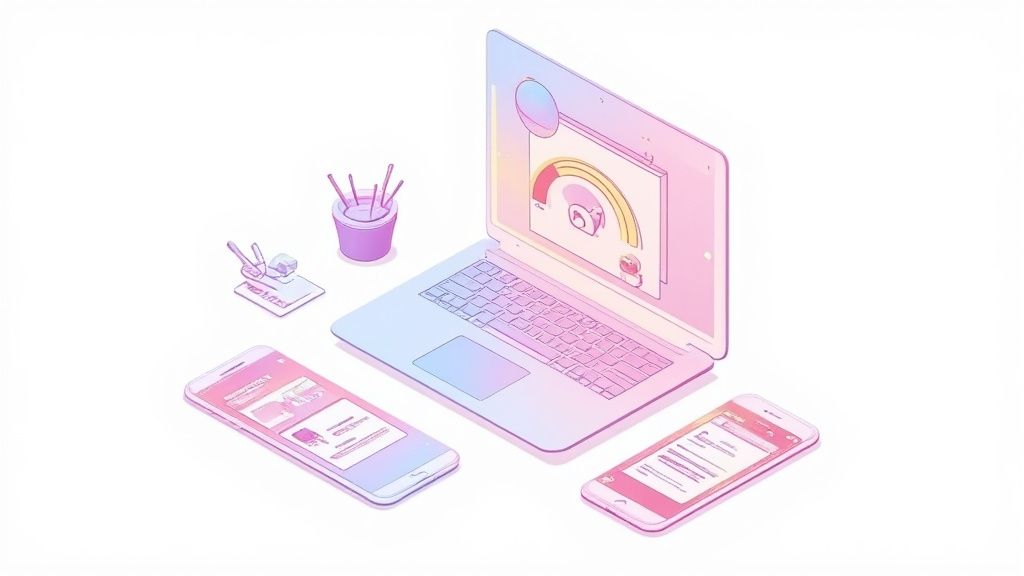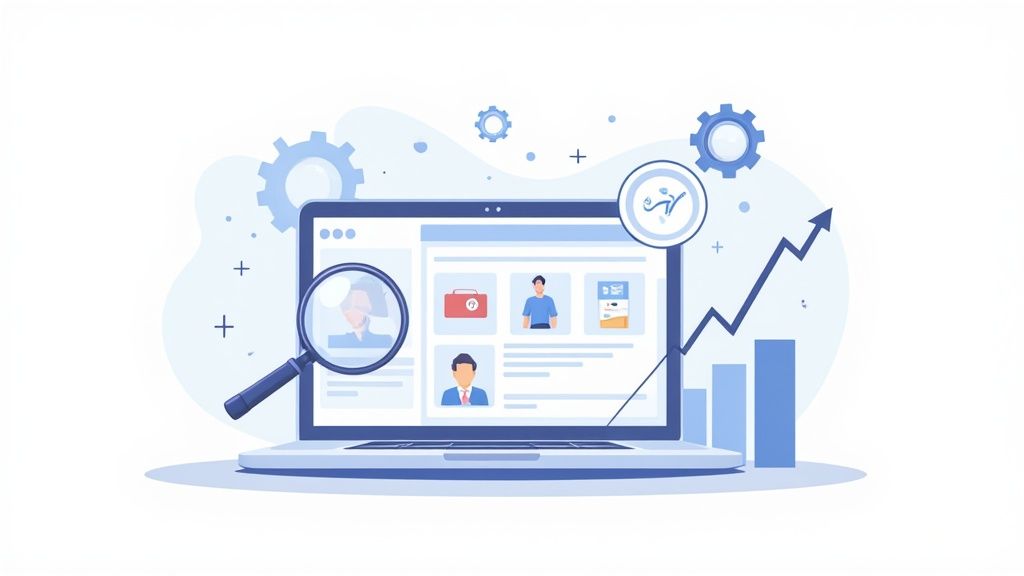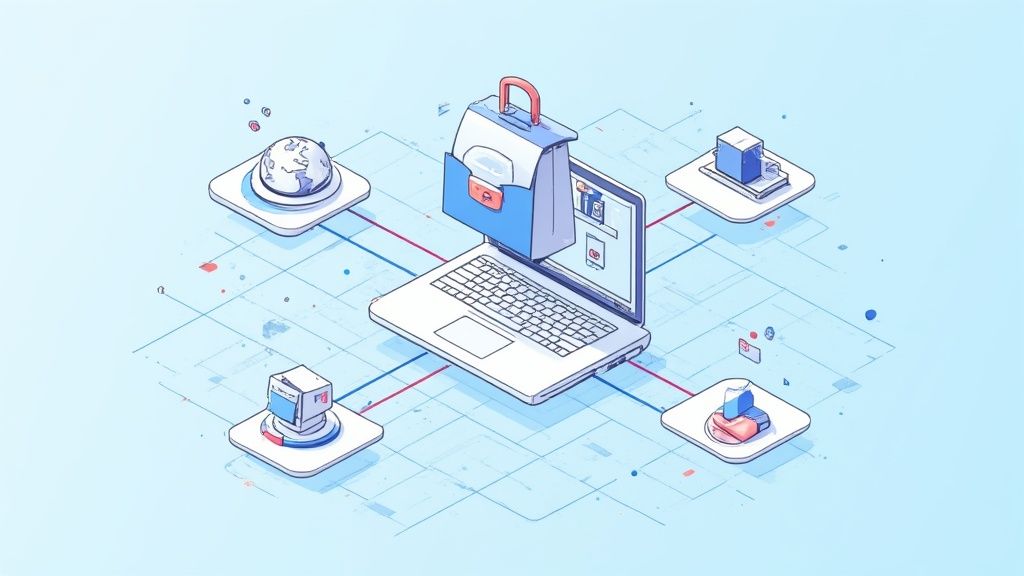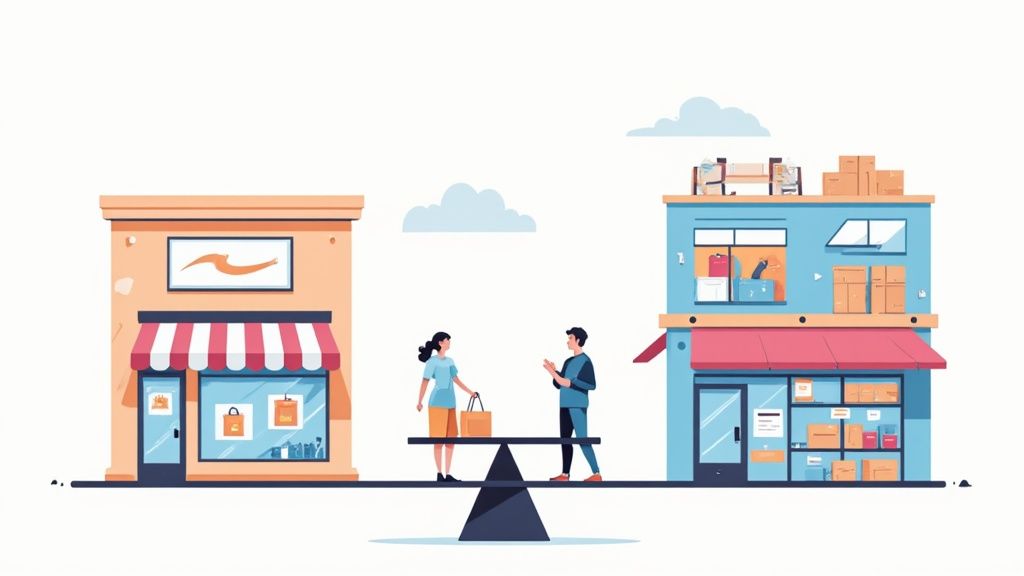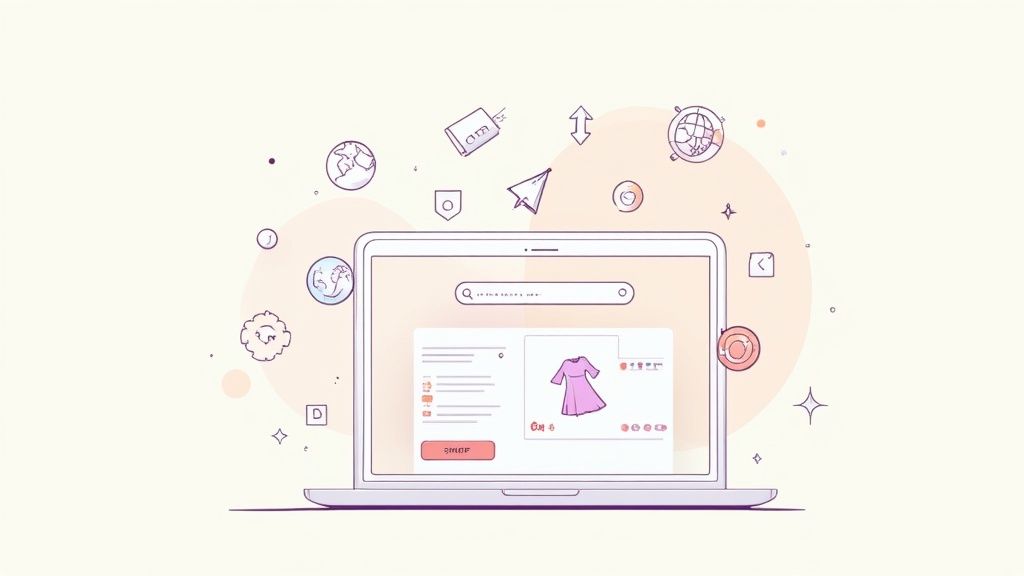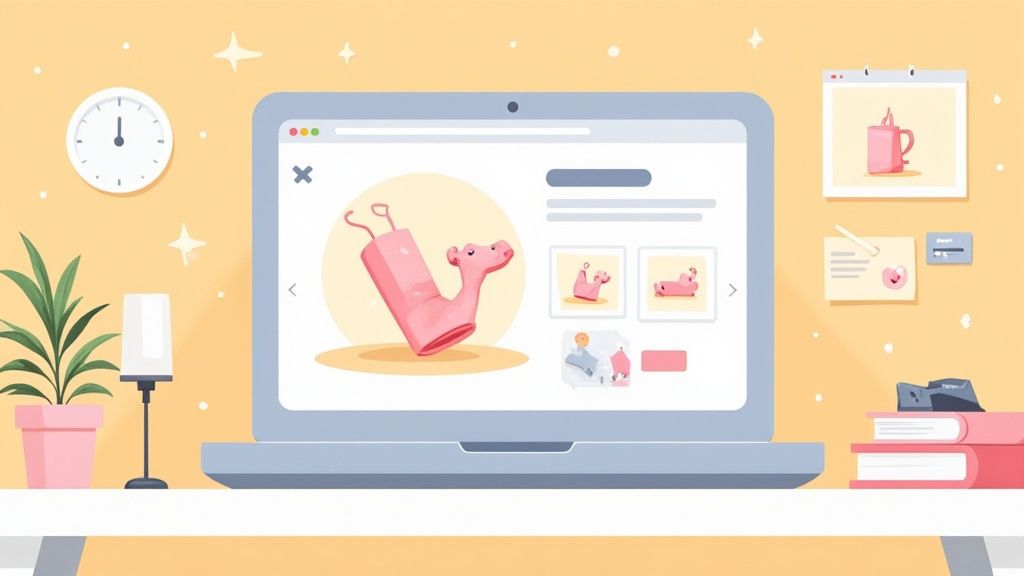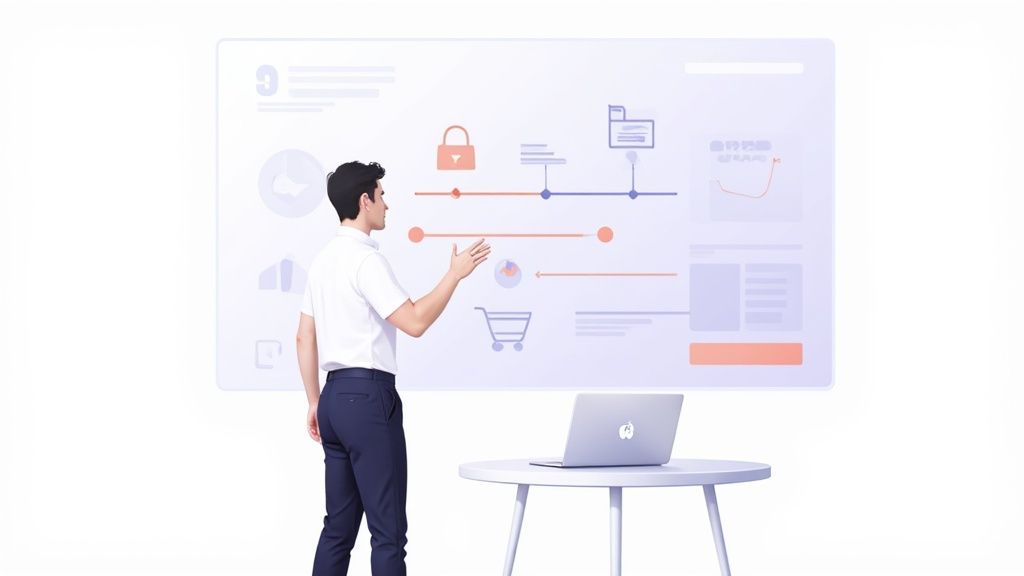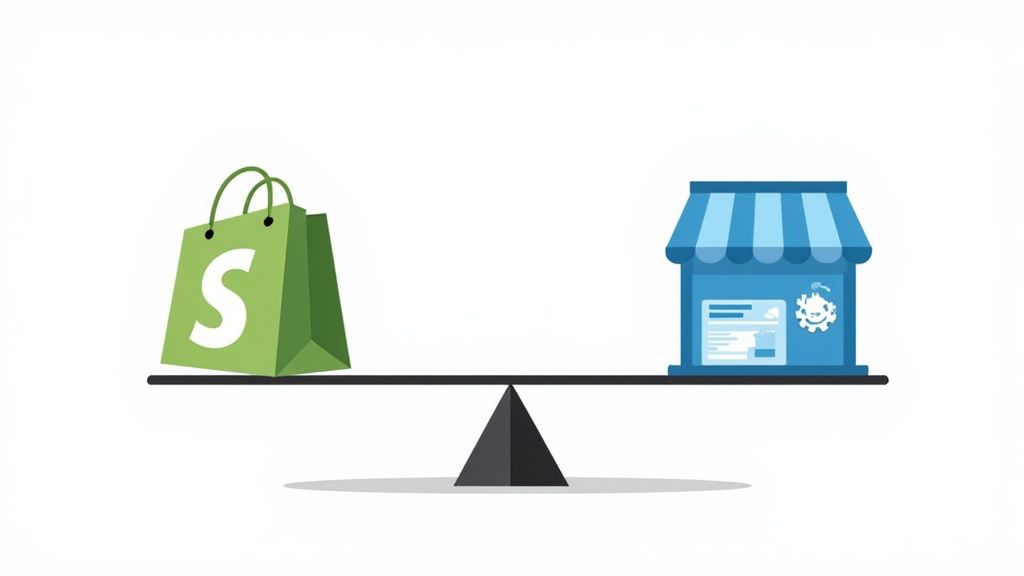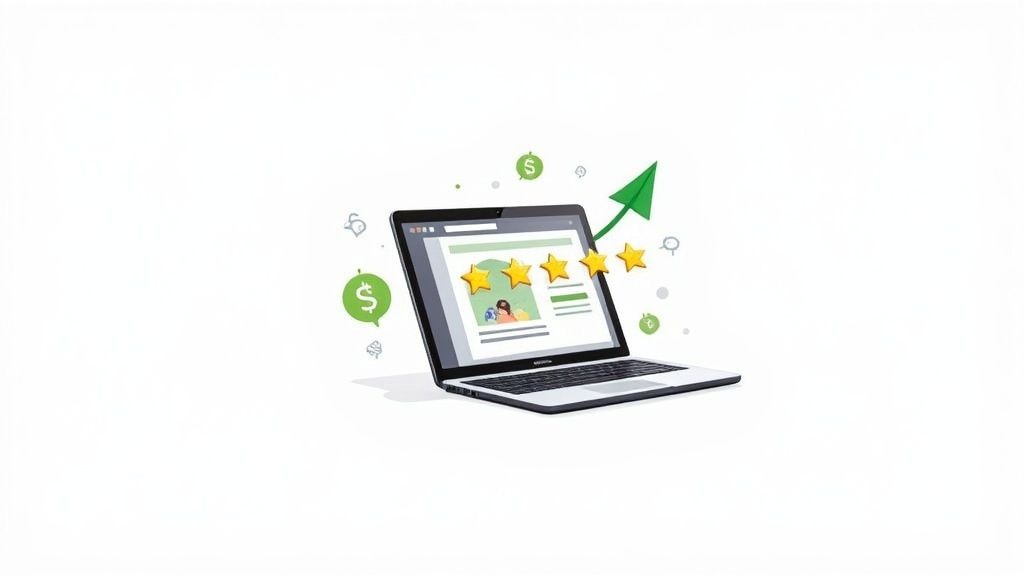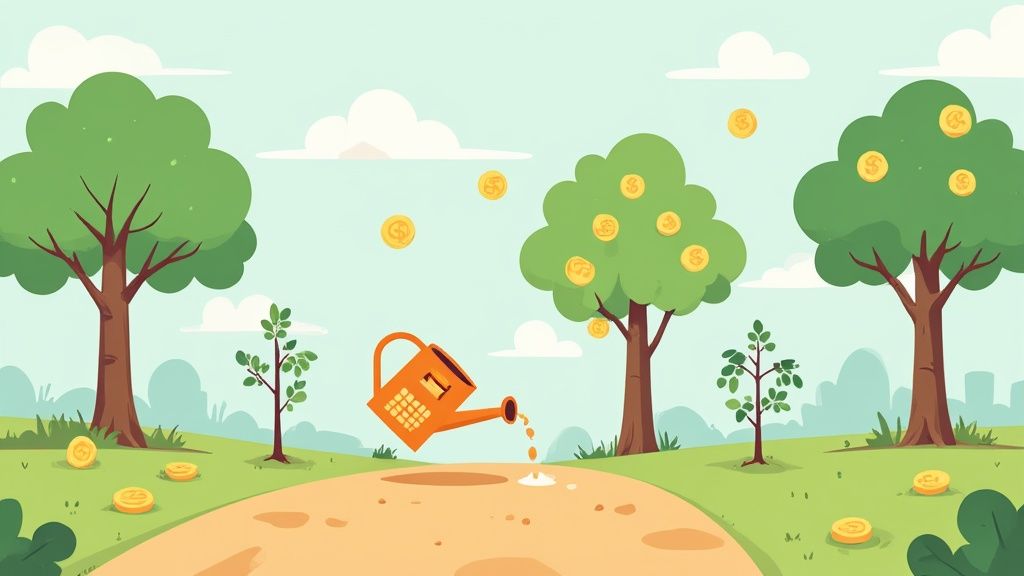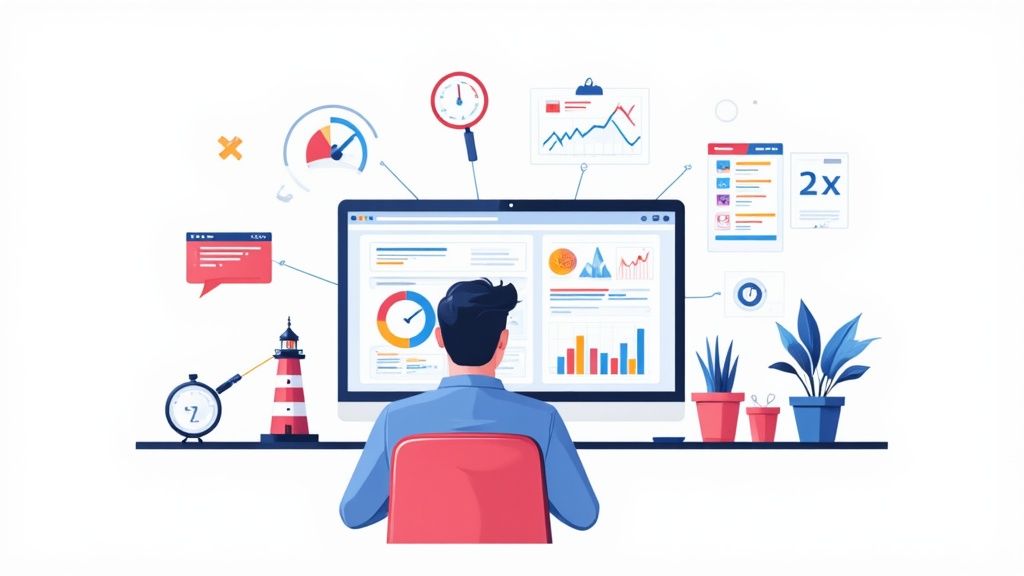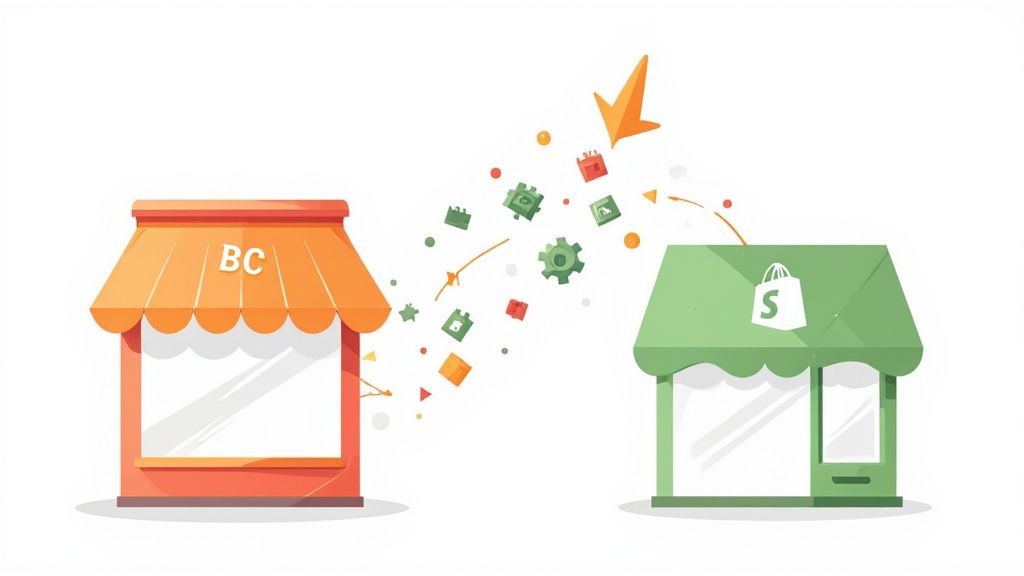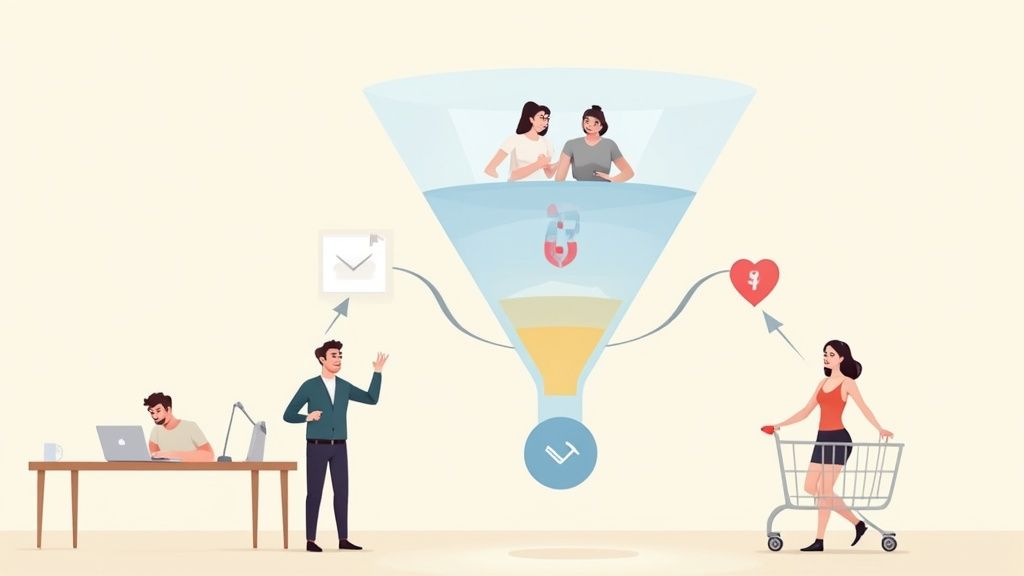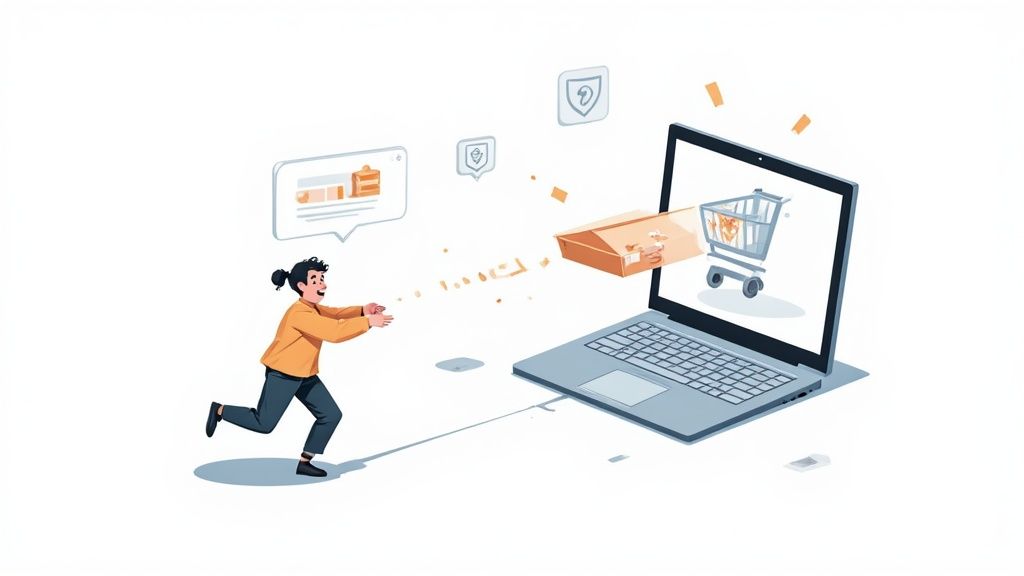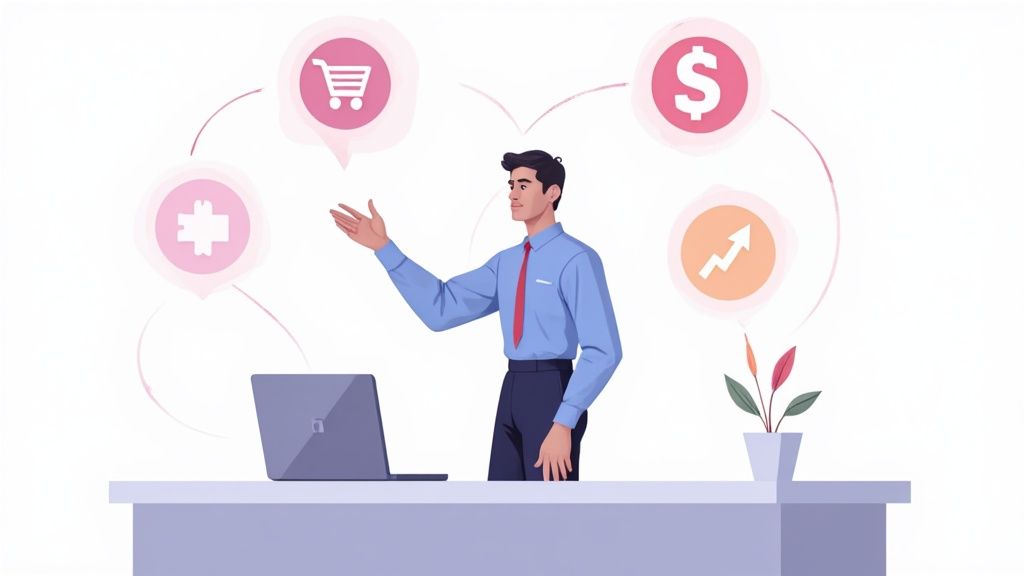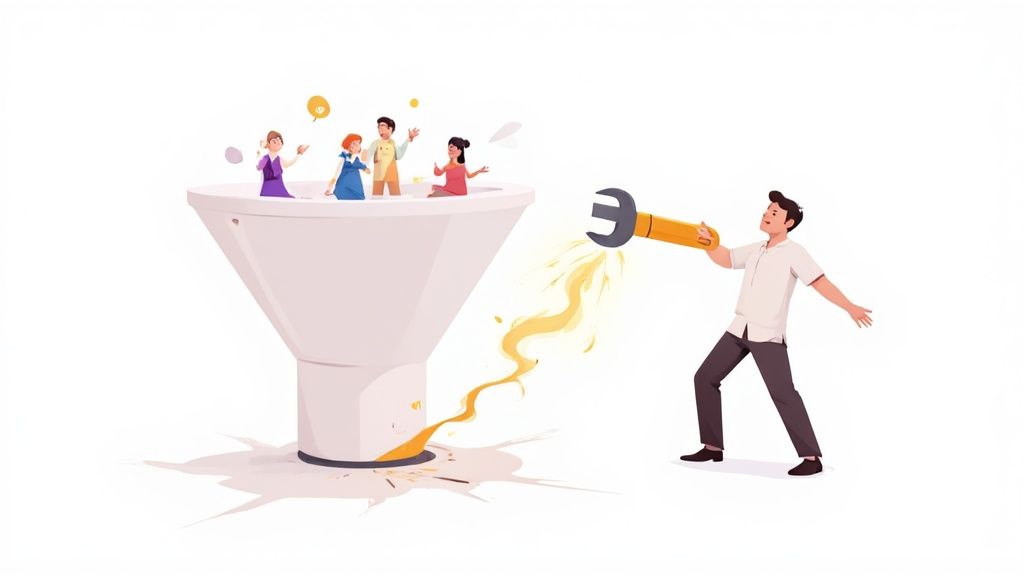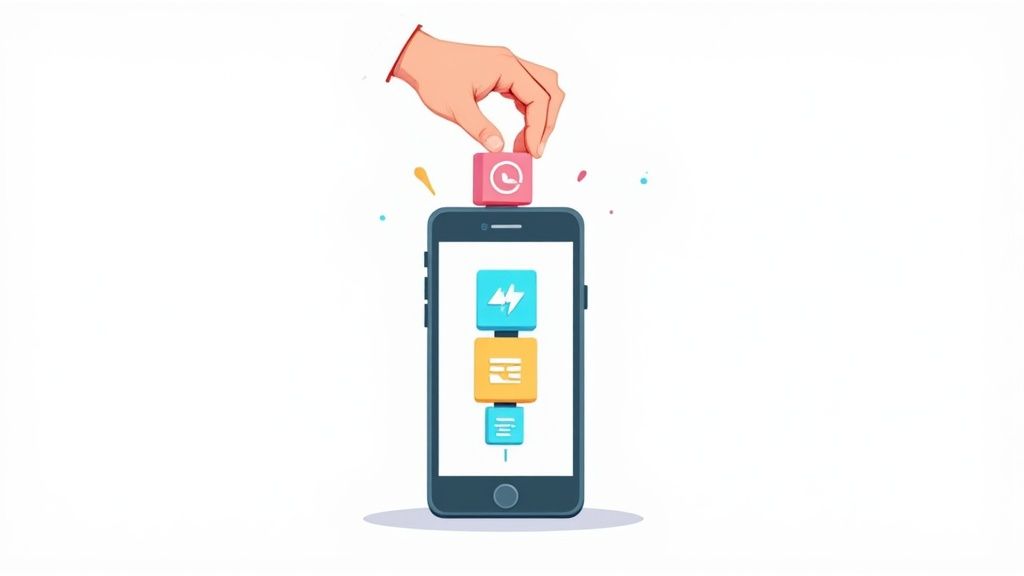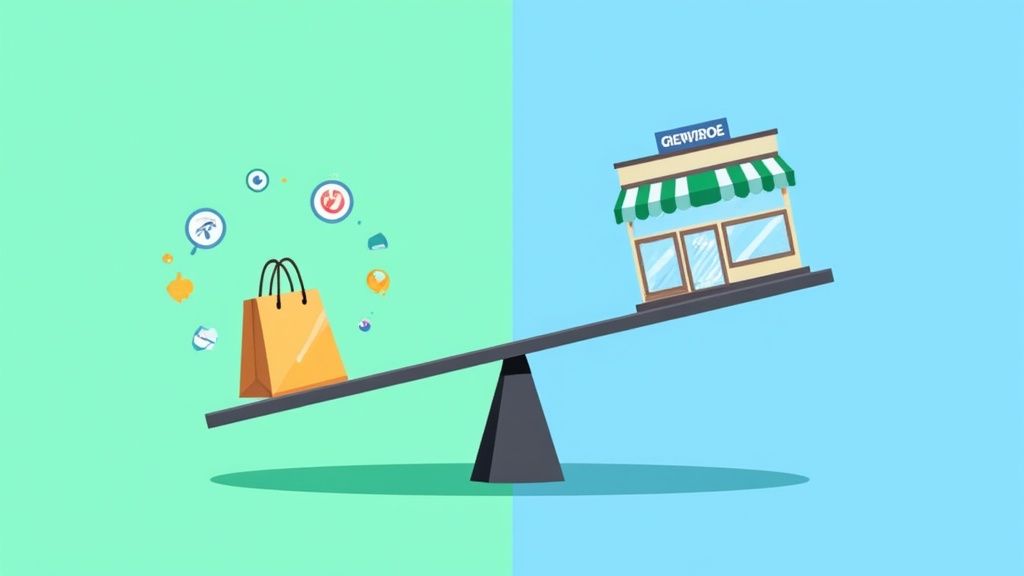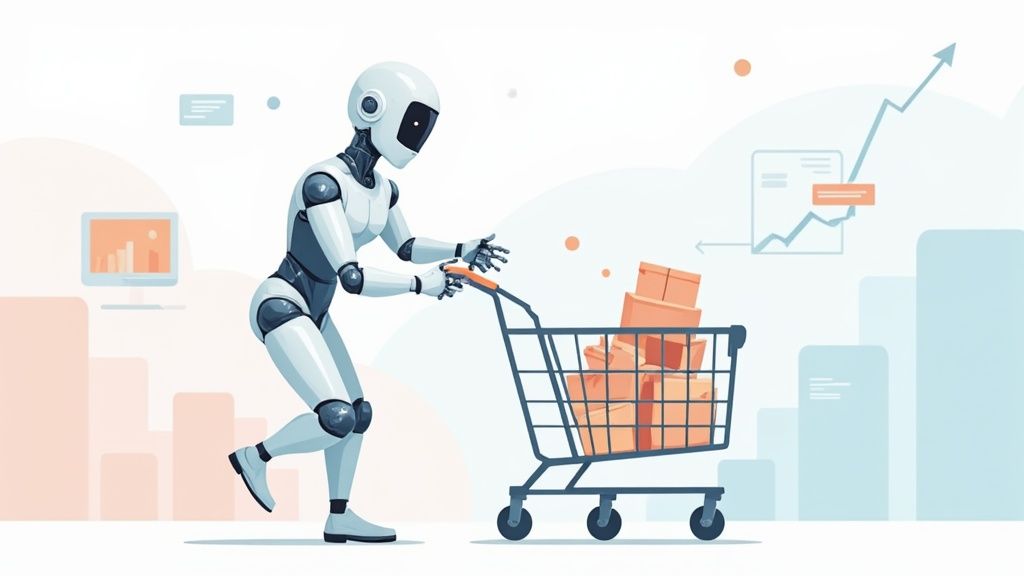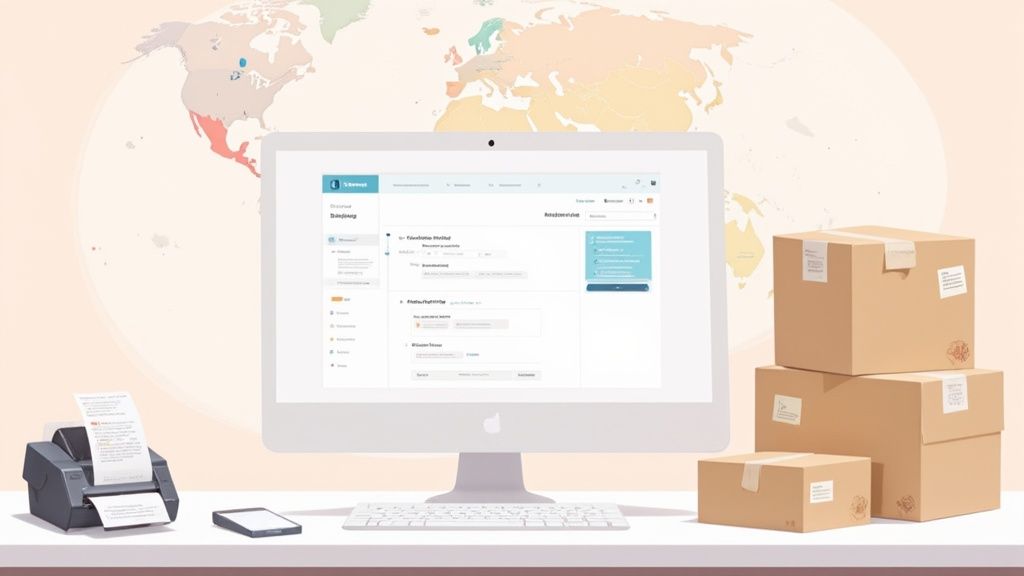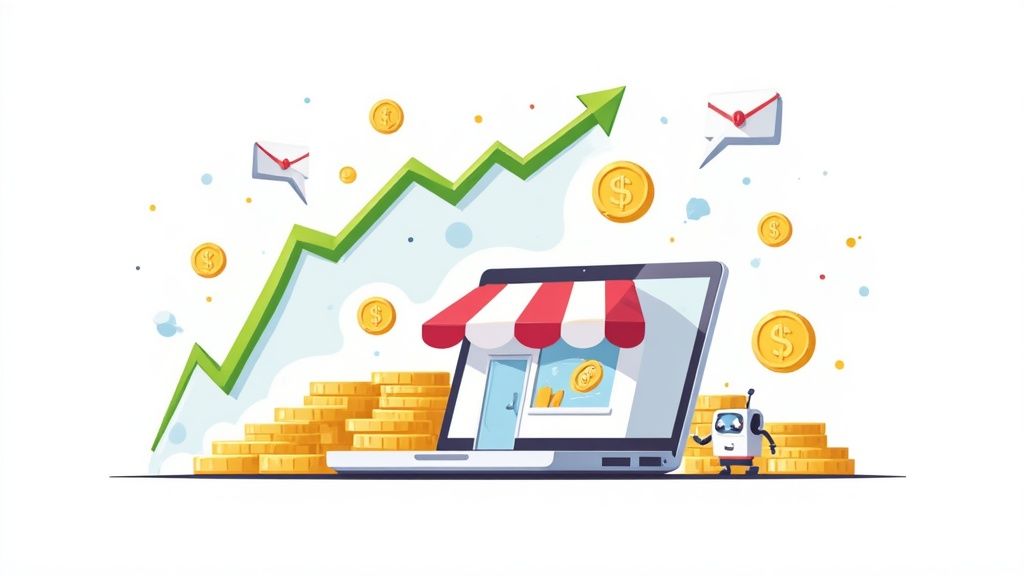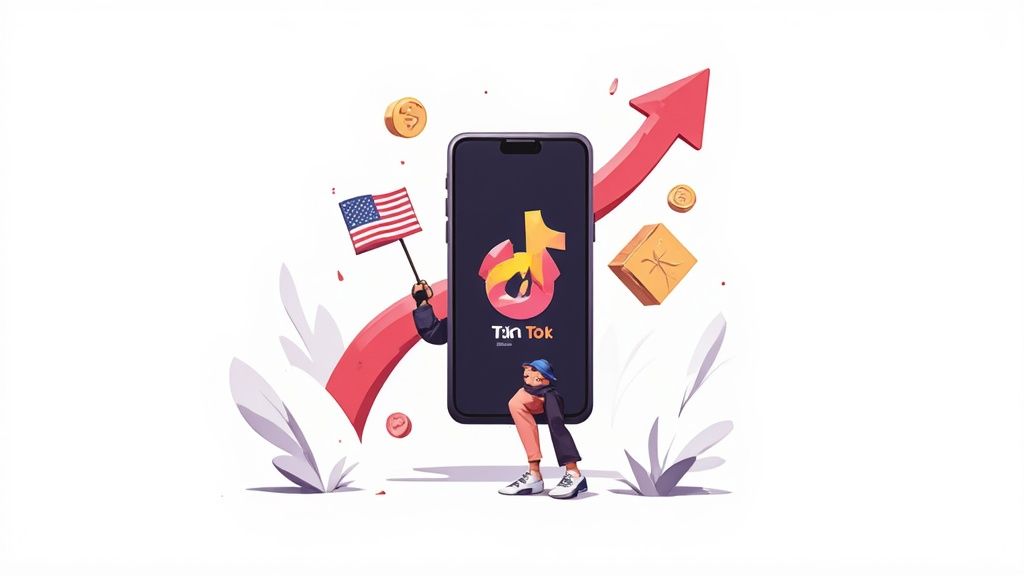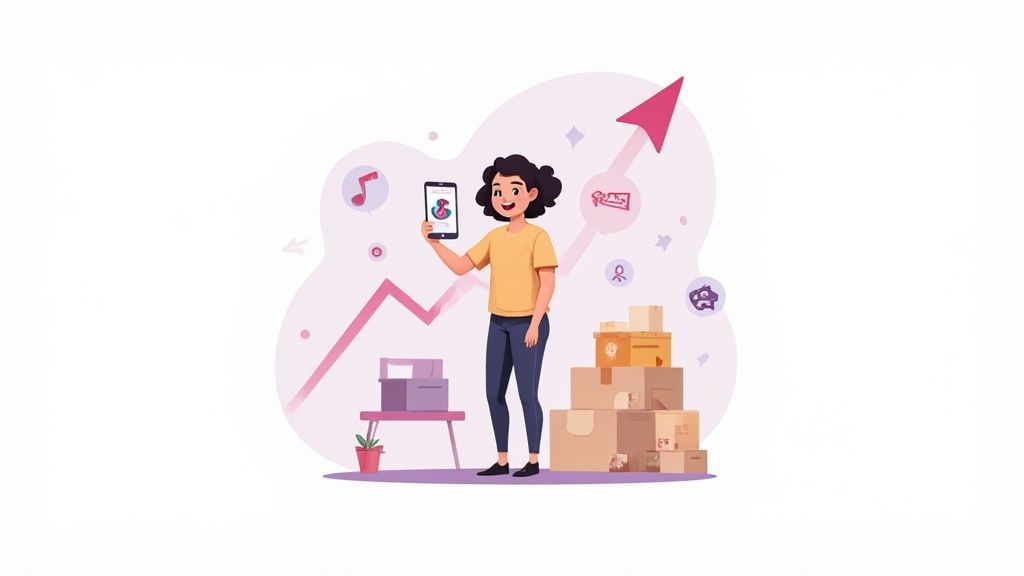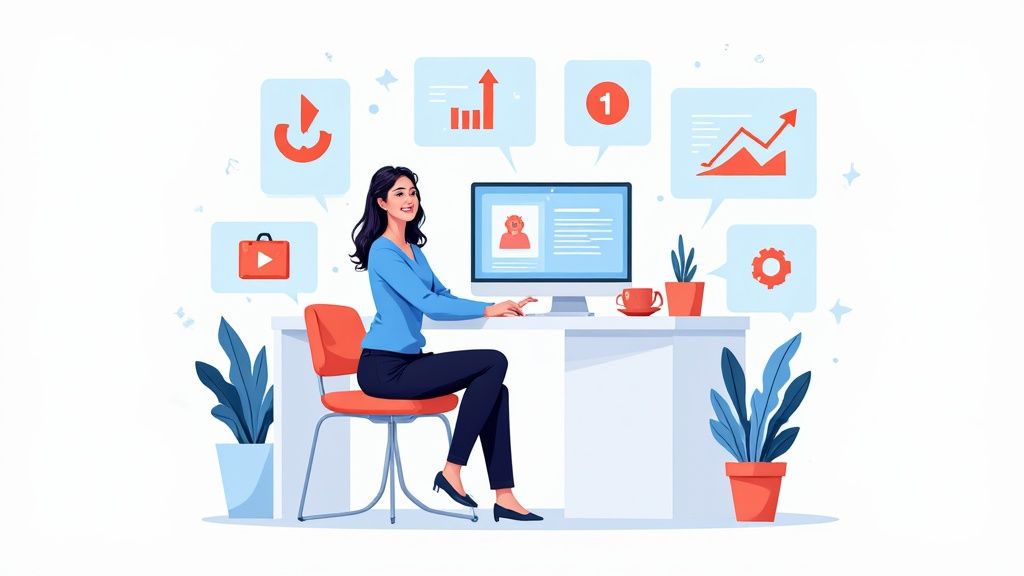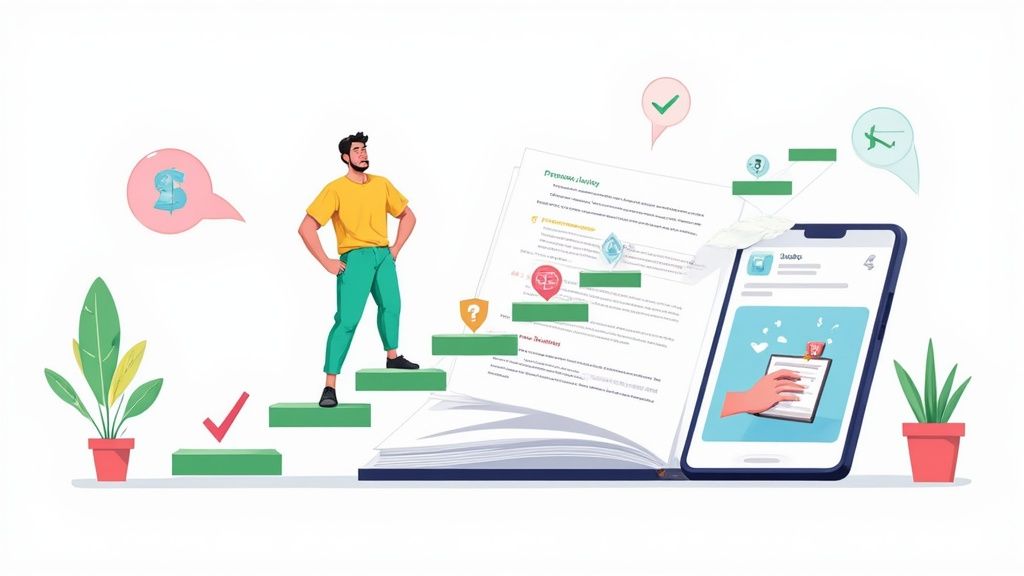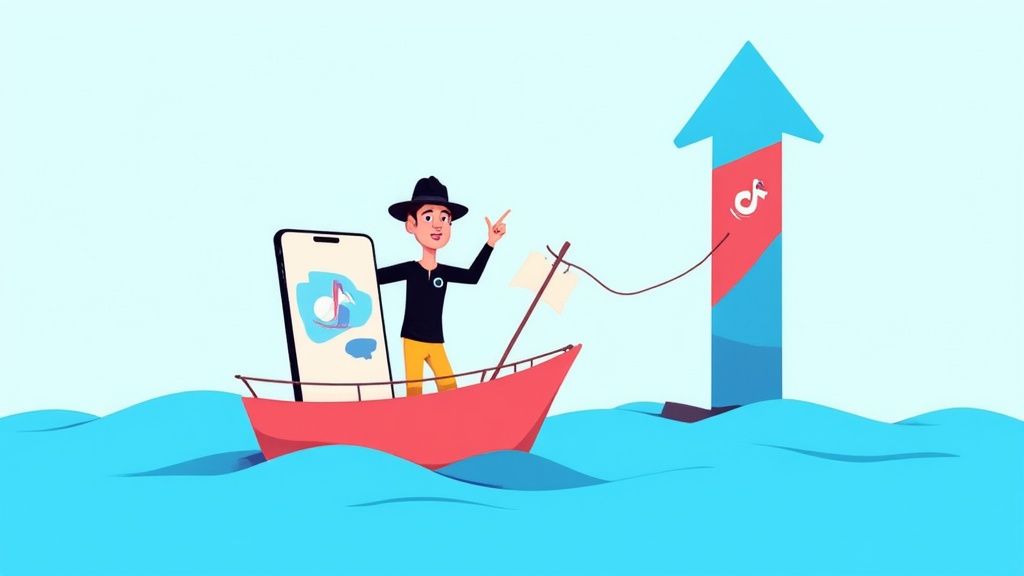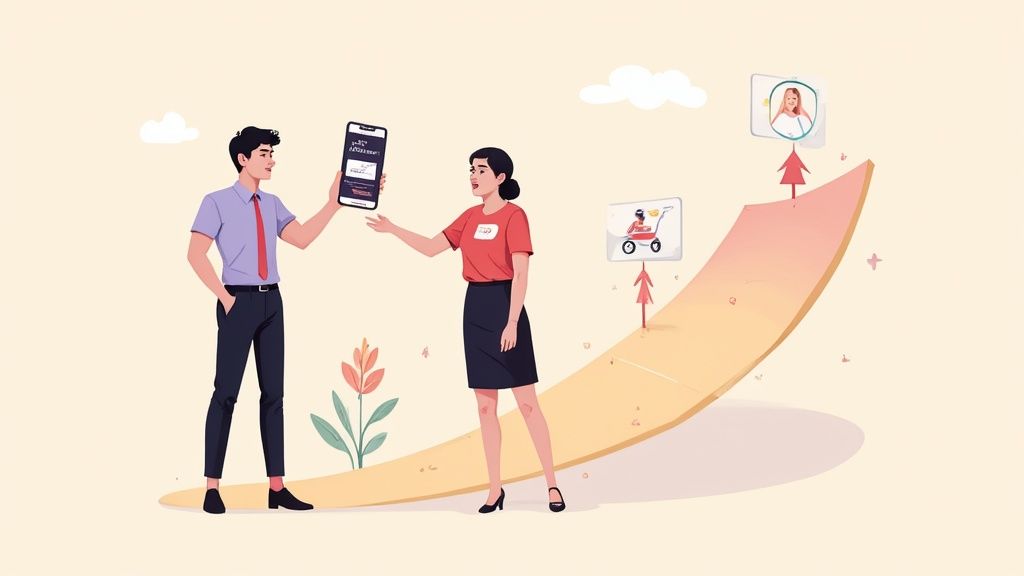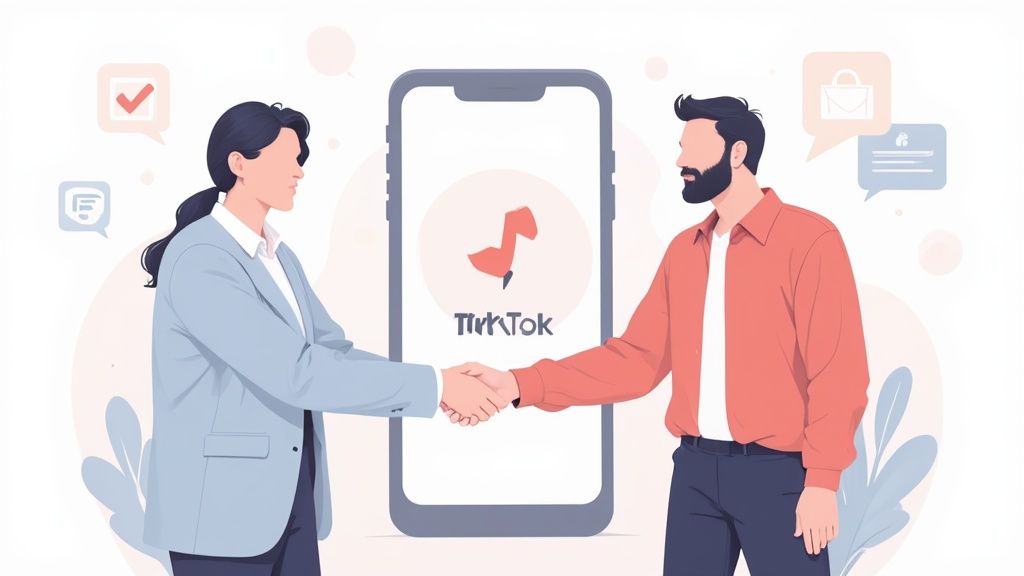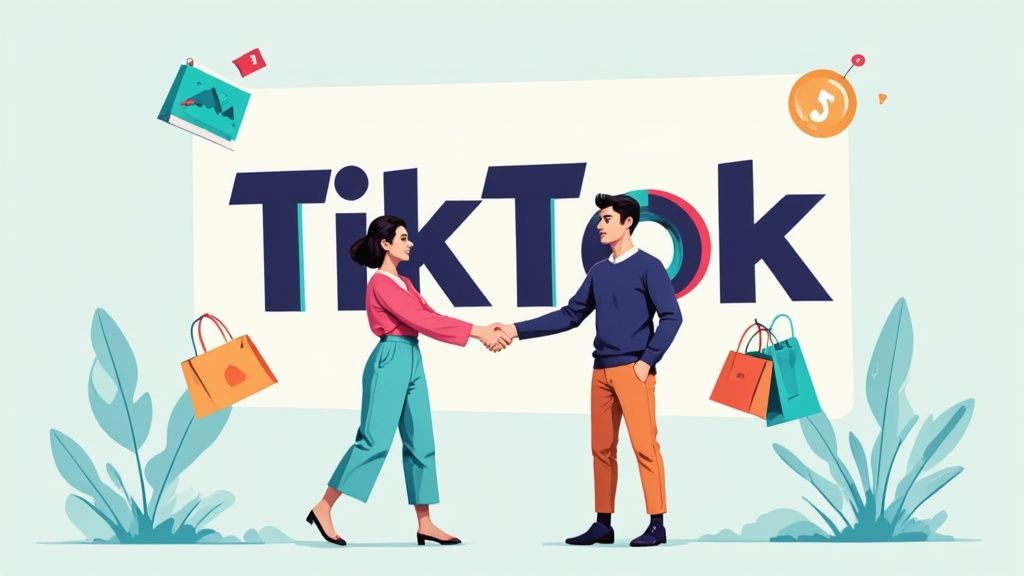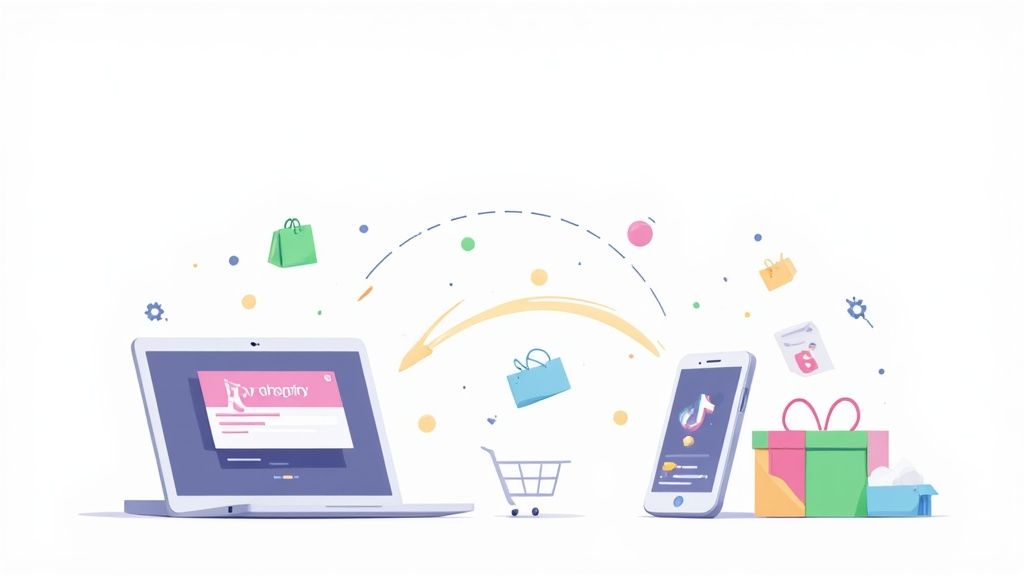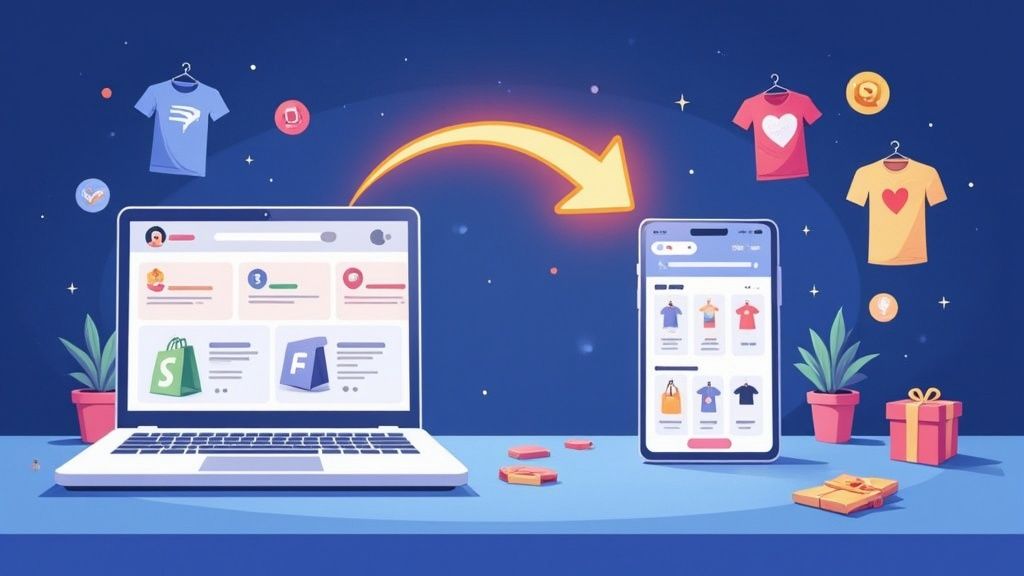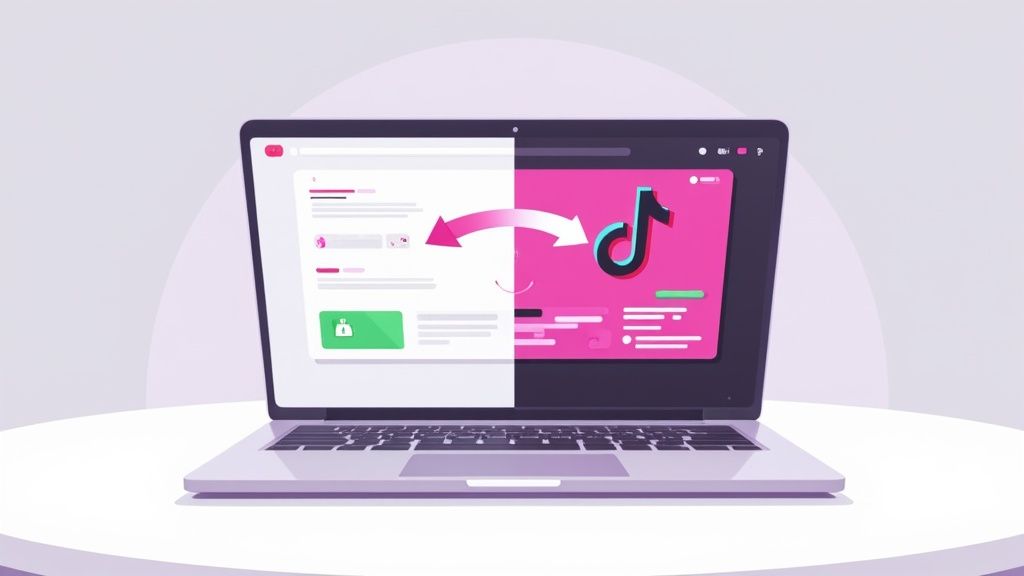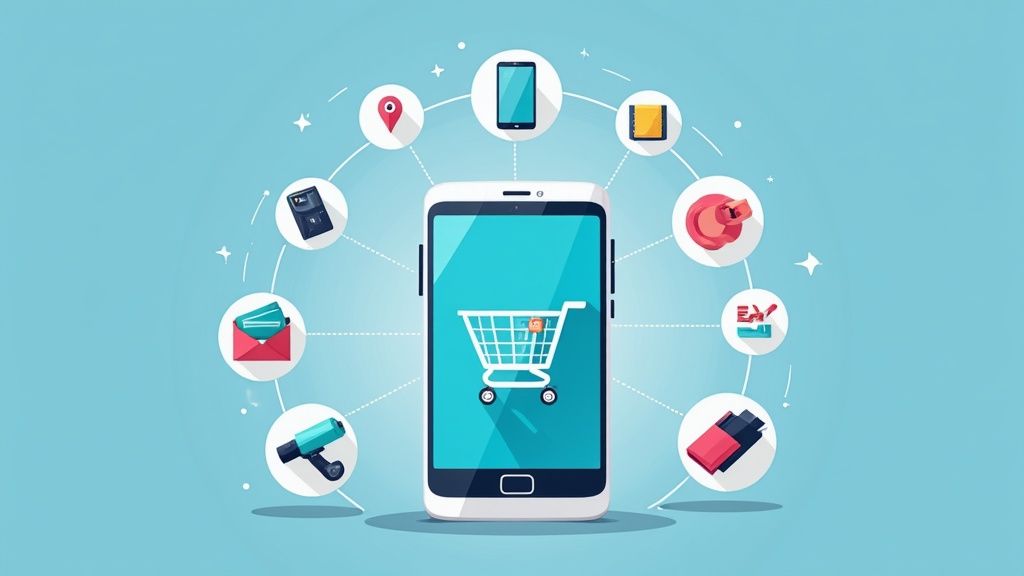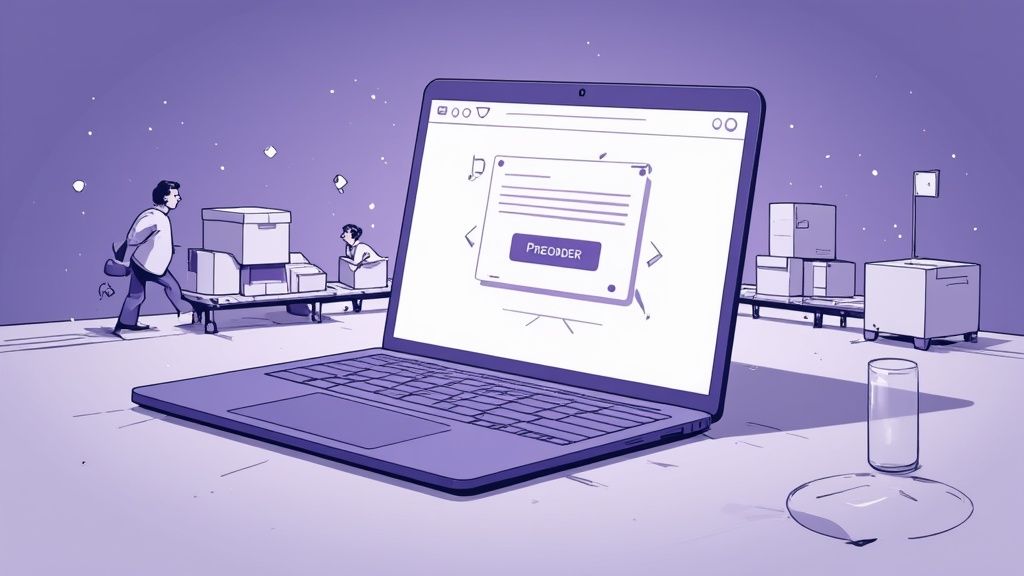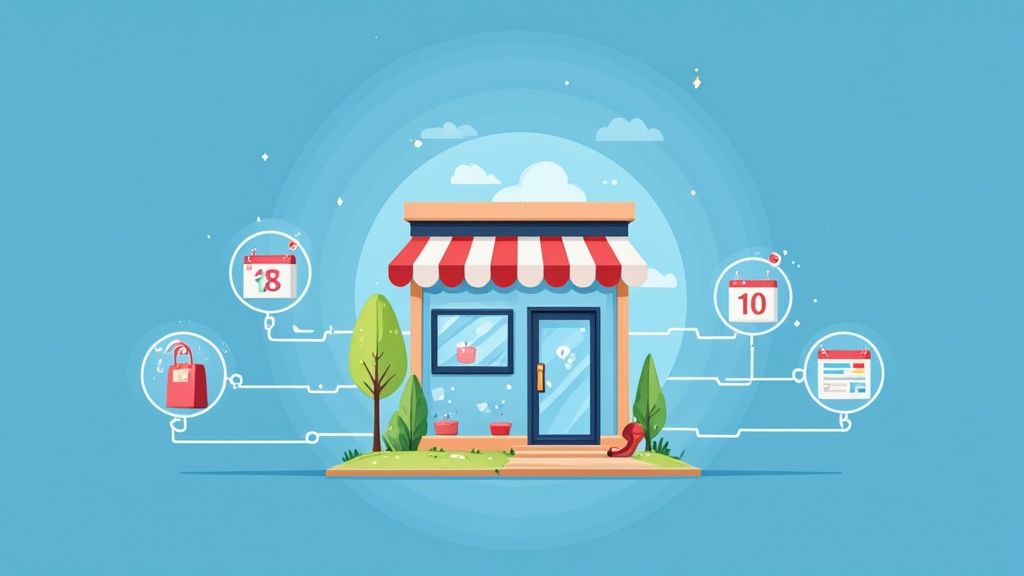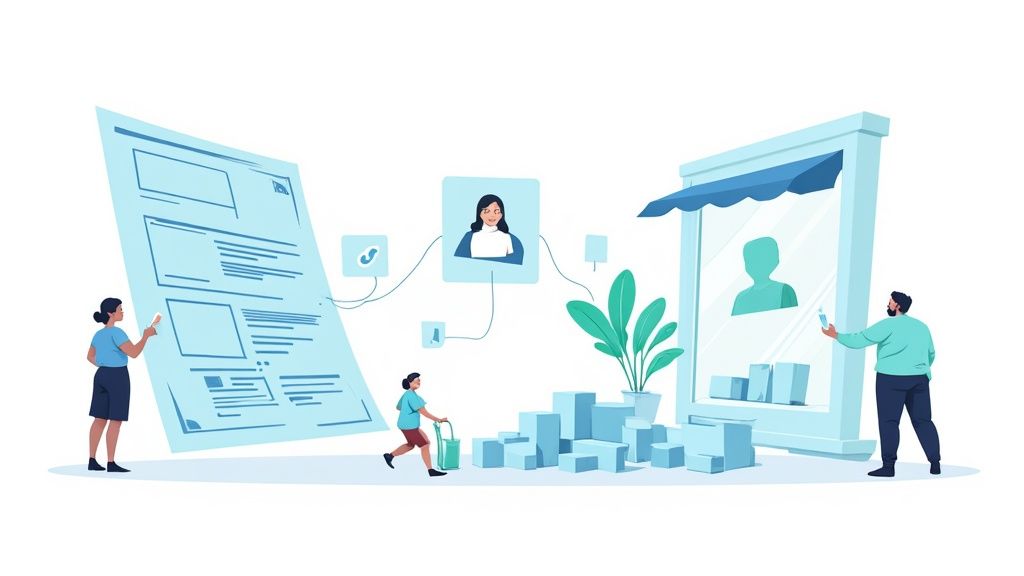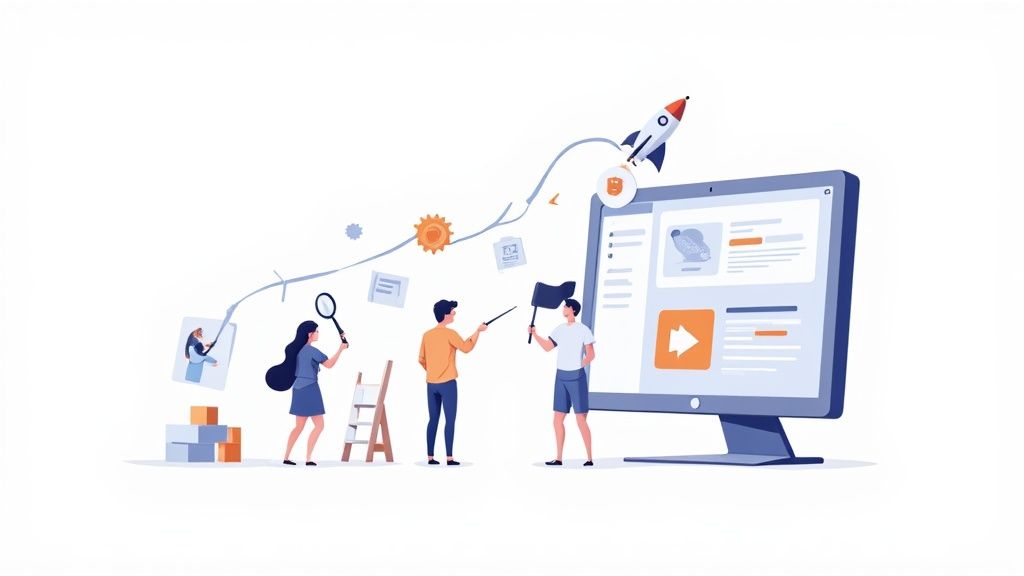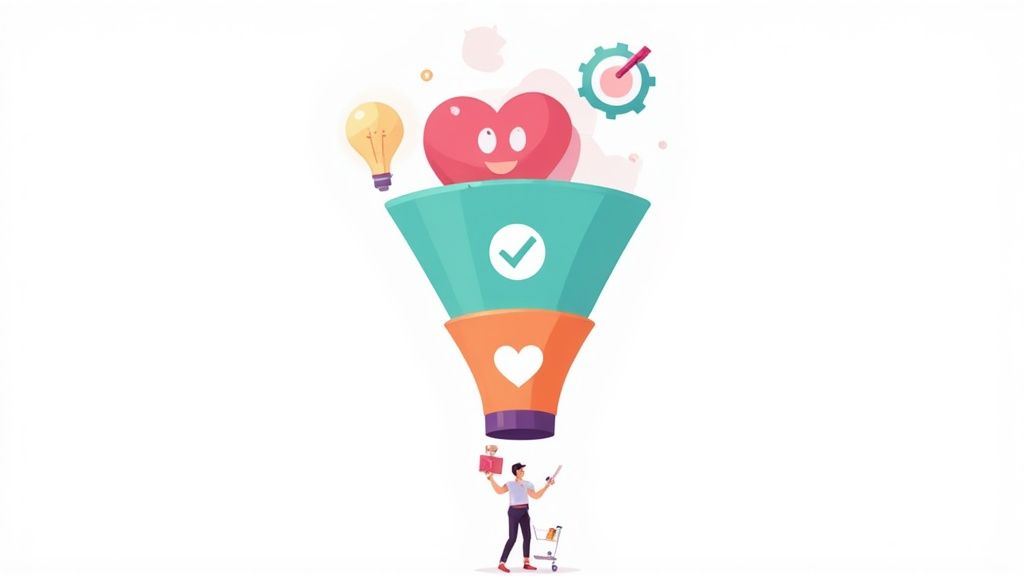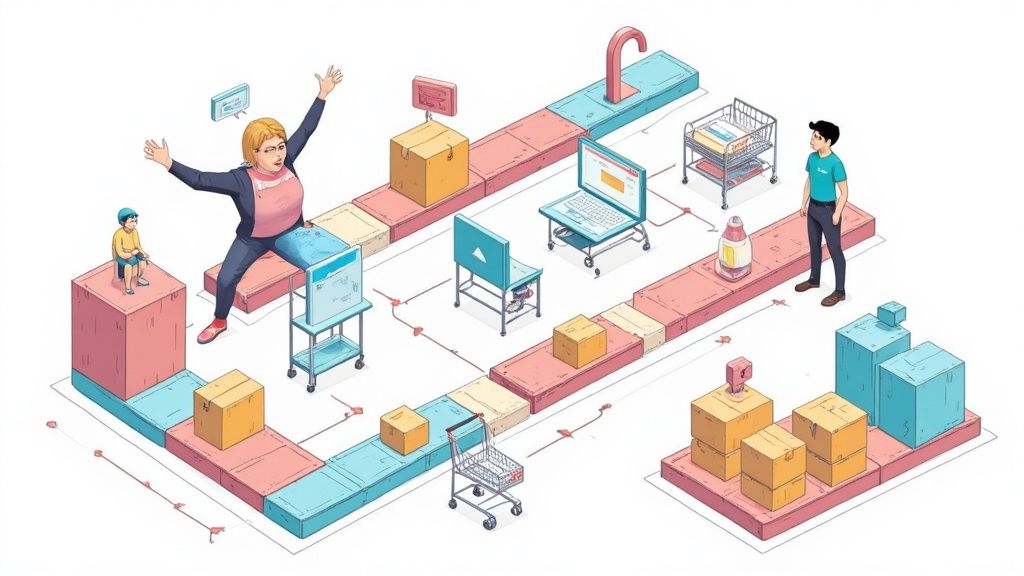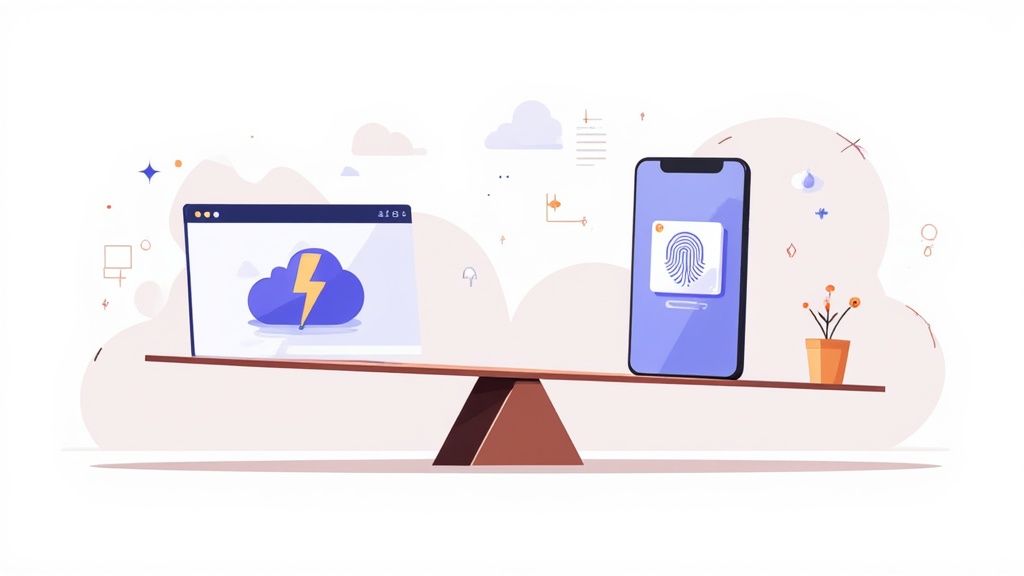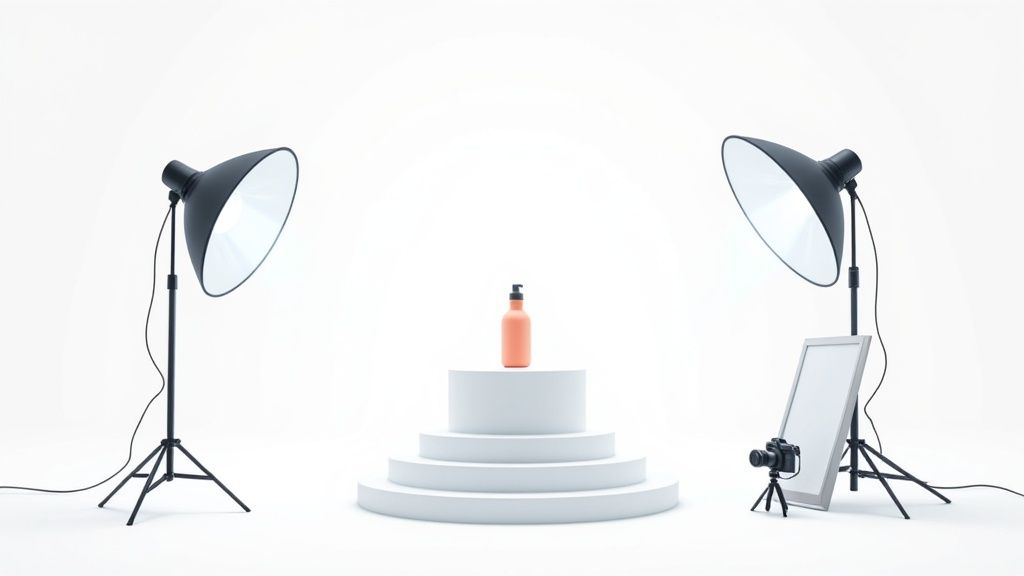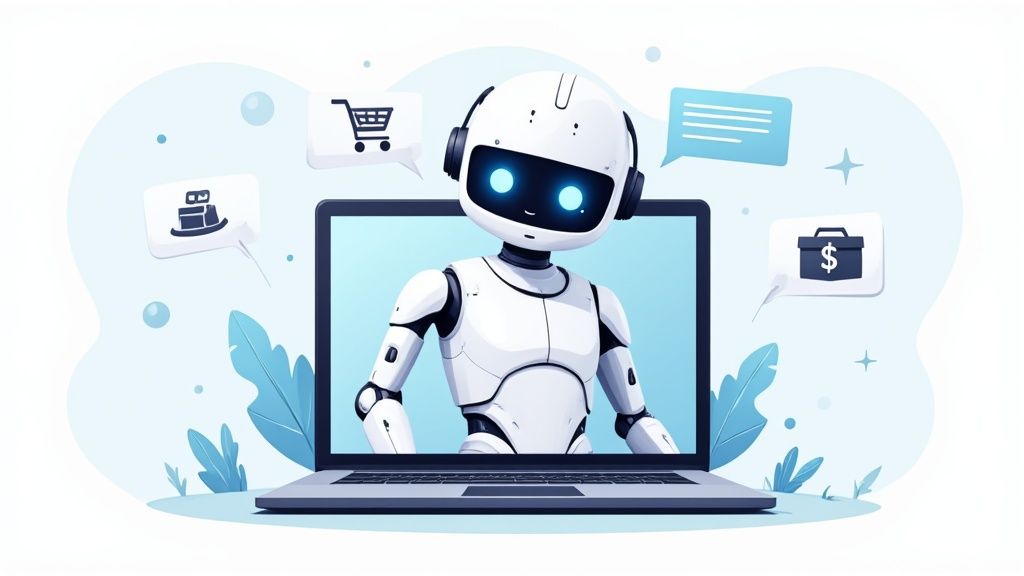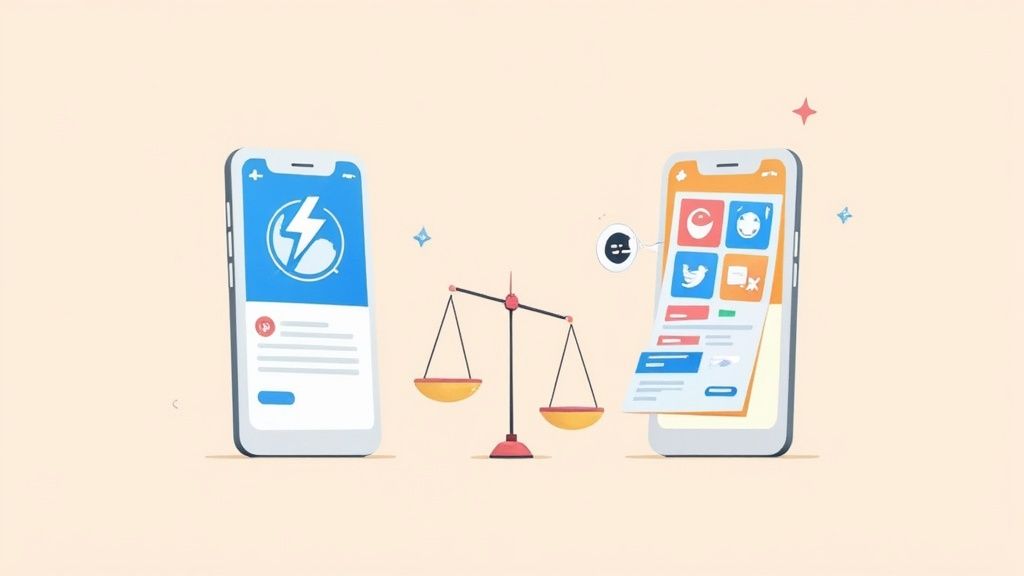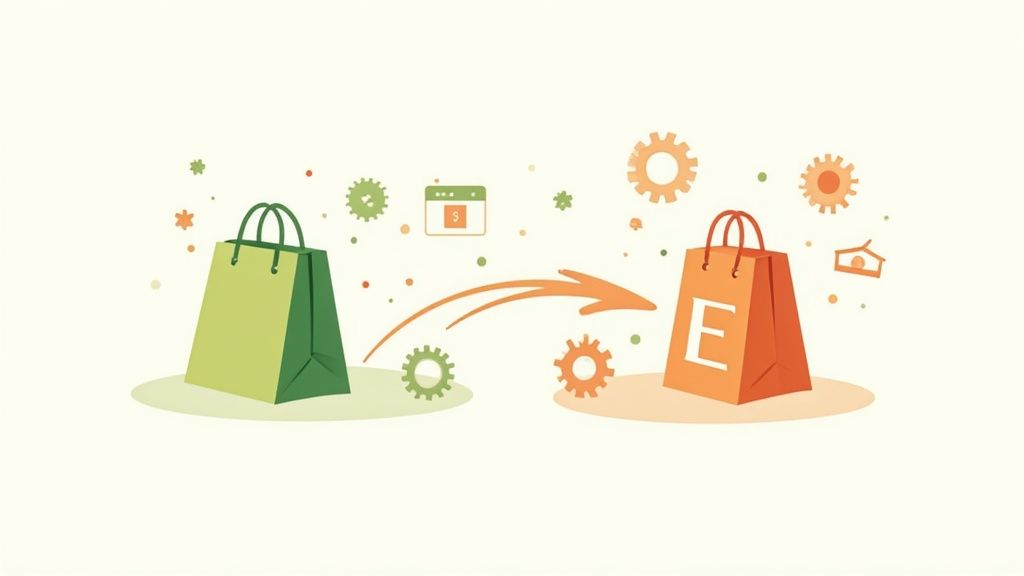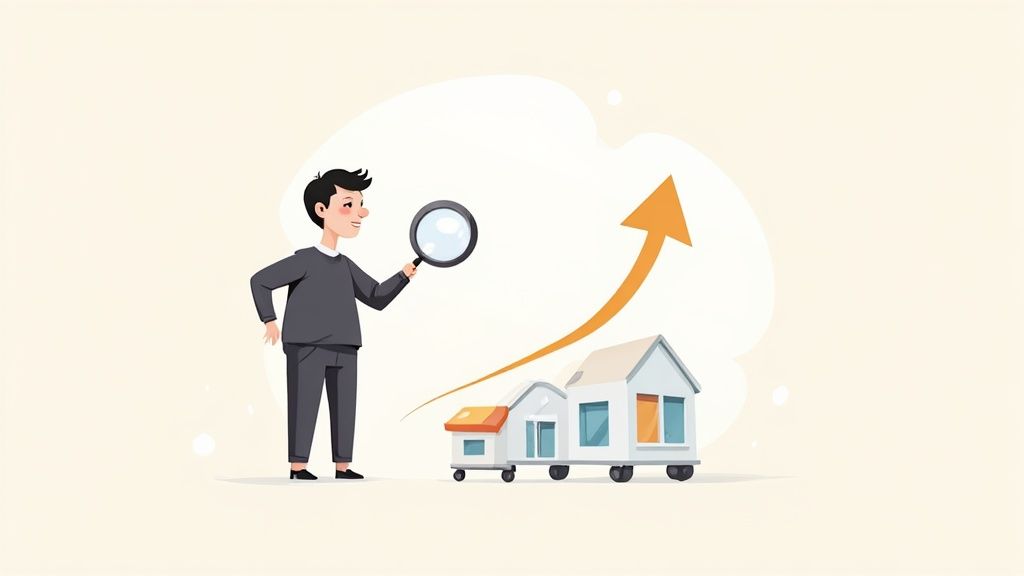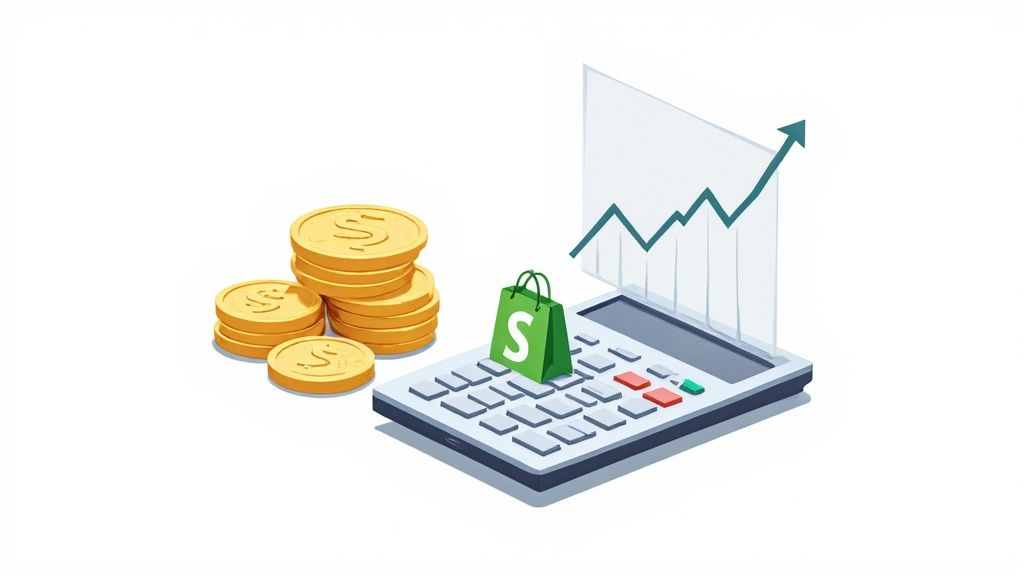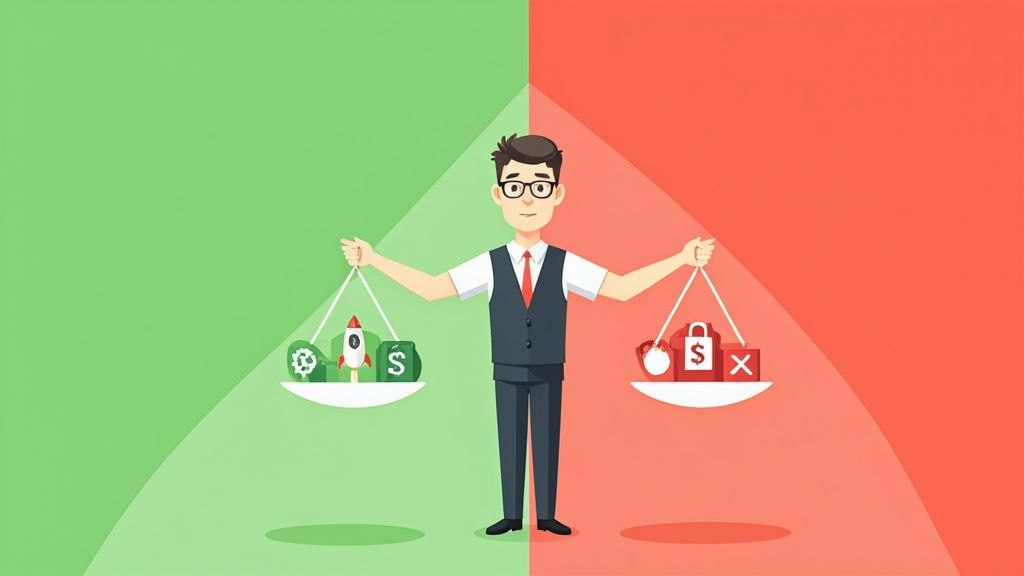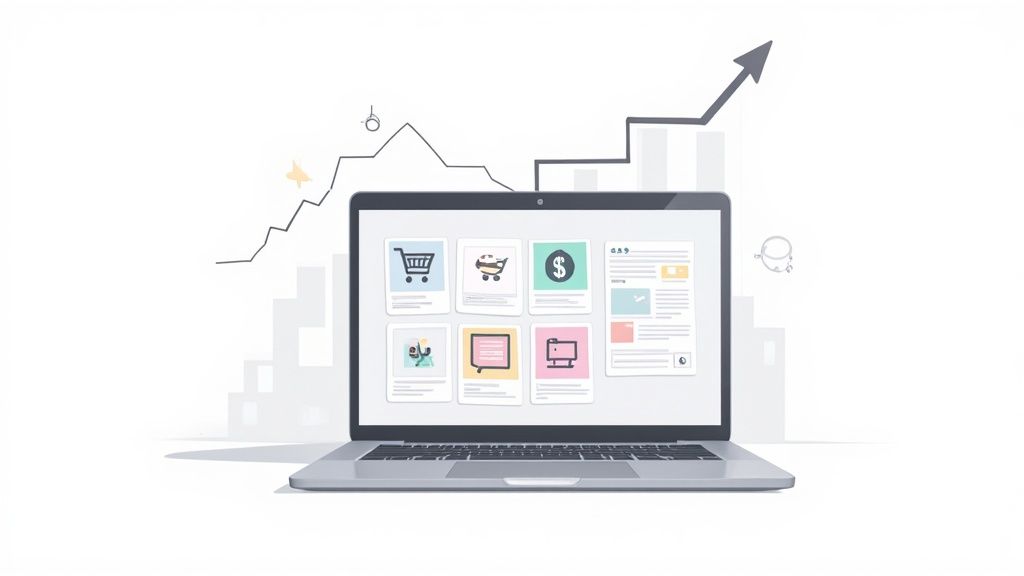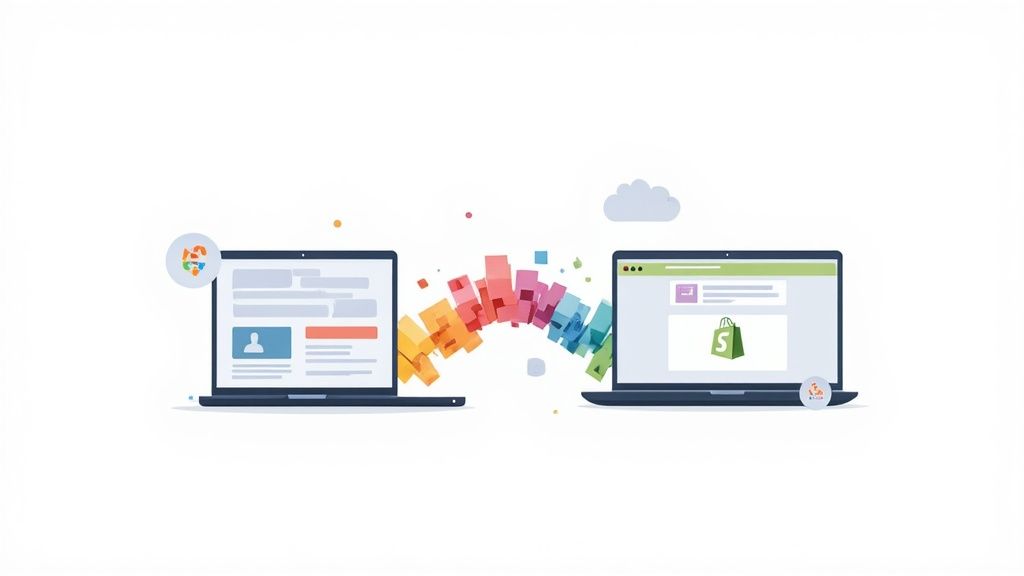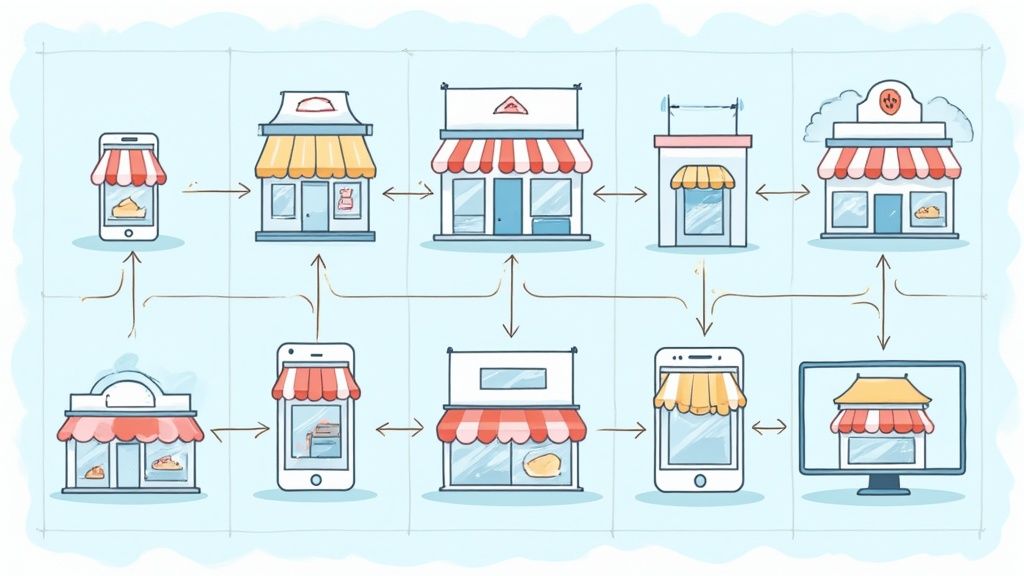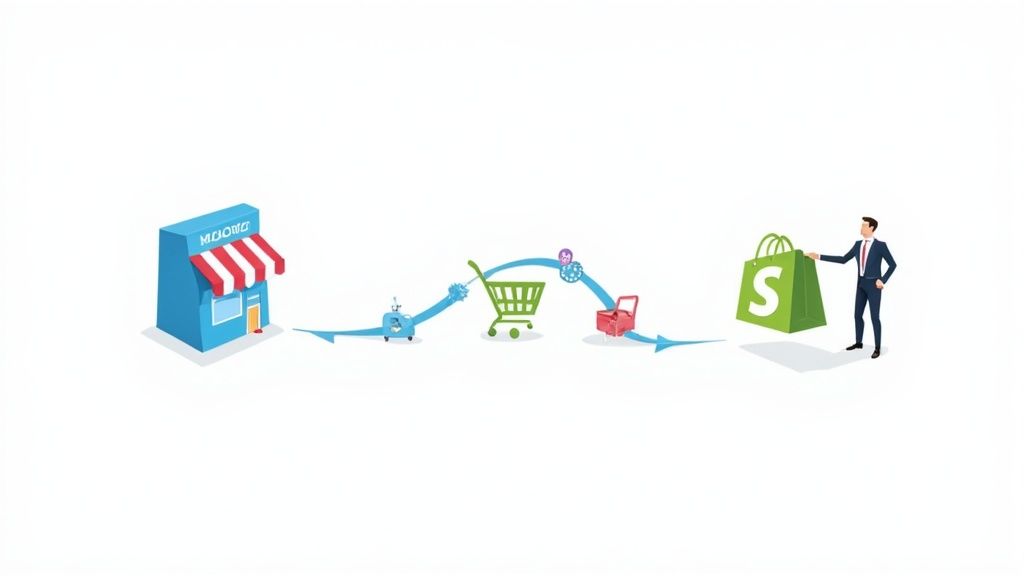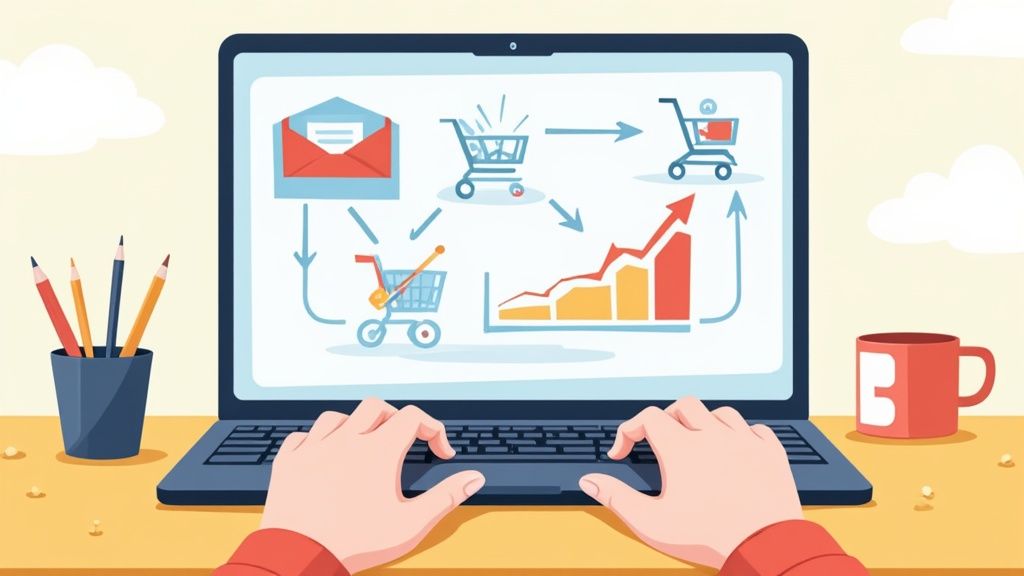
At its core, ecommerce email marketing automation is about sending the right message to the right person at the right time—without you having to lift a finger for every send. Think of it as the engine powering personalized communication at scale. It’s what lets you automatically send welcome series, abandoned cart reminders, and post-purchase follow-ups that feel like one-to-one conversations, not generic email blasts.
Building Your Automation Foundation
Before a single automated email can start making you money, you have to lay the groundwork. Skipping the setup is like building a house on sand; it might look okay for a little while, but it's guaranteed to crumble. Getting the right platform and configuring it correctly is non-negotiable for long-term success.
This all starts with picking the right tools for the job. And while there are tons of options out there, your choice should always come down to what will directly impact your store's growth.
Choosing the Right Automation Platform
The market is flooded with email platforms, but for serious ecommerce brands, the list gets much shorter. You'll often see names like Klaviyo and Omnisend come up, and for good reason. Your number one consideration should be how deeply a platform integrates with your ecommerce ecosystem, whether that’s Shopify, BigCommerce, or something else.
Why is this so important? A seamless connection is what allows the platform to pull in rich customer data—like purchase history, browsing behavior, and even product interests. This data is the fuel for every effective automation you'll ever build.
Here are the critical factors I always evaluate:
- Deep Ecommerce Integration: Can the platform tap into all your customer, order, and product data without needing clunky workarounds or custom code?
- Segmentation Capabilities: How granular can you get? You need a tool that can instantly tell the difference between a first-time buyer, a window shopper, and a VIP customer who has spent over $1,000.
- Scalability and Pricing: Does the pricing model make sense as you grow? You want to avoid platforms that punish you with surprise fees just for building a bigger list.
Take a look at Klaviyo's platform. It's a perfect example of how centralizing customer data gives you the power to create truly personal marketing.
This kind of unified customer view is exactly what you're looking for. Every click, every purchase, every interaction is tracked and ready to trigger a specific, relevant automation.
To help you compare, I've put together a quick table looking at some of the most popular choices for ecommerce stores.
Key Features of Top Ecommerce Automation Platforms
Ultimately, the best tool depends on your specific needs, but for most stores serious about growth, a platform built for ecommerce like Klaviyo or Omnisend will give you a much higher ceiling than a generalist tool.
Essential Technical Setup for Deliverability
Once you’ve picked your platform, the next step is a crucial one that too many brands gloss over: making sure your emails actually land in the inbox. Email providers like Gmail and Outlook are getting smarter and stricter about filtering spam. Authenticating your domain is how you tell them, "Hey, these emails are legit and they’re really from me."
You’ll need to get comfortable with your domain’s DNS settings to configure two key records:
- SPF (Sender Policy Framework): This is a list of the mail servers that are officially allowed to send emails on behalf of your domain.
- DKIM (DomainKeys Identified Mail): This adds a digital signature to your emails, which proves the message hasn't been altered in transit.
Setting these up is a one-time technical task, and your email platform will give you the exact values to add. Don't skip this. Without proper authentication, even the most brilliantly crafted ecommerce email marketing automation workflow is destined for the spam folder.
Key Takeaway: Platform selection and technical authentication are the two pillars of your automation foundation. A powerful tool is useless if its emails don't reach the inbox, and great deliverability means nothing without the right data to create relevant messages.
Finally, you’ll need to migrate your existing subscriber list. A clean import is vital here. Make sure you only bring over people who have actually engaged with you recently, and tag them properly based on any data you have. Starting with a healthy, organized list sets you up for high-performing automations from day one.
Designing Your Core Money-Making Workflows
Okay, with the foundational pieces in place, it's time for the fun part: building the automated systems that actually make you money. This is where ecommerce email marketing automation stops being a technical chore and starts acting like your best salesperson—one that works 24/7.
We're going to focus on three essential workflows that every single online store needs. Seriously. These aren't just random emails; they're strategic sequences designed to hit customers at the most critical moments of their journey. Think of them as your secret weapon for making a great first impression and even recovering sales you thought were long gone.
Before we dive into building, it helps to see how the whole system connects. The link between your store and your email platform is what makes all this data-driven magic possible.
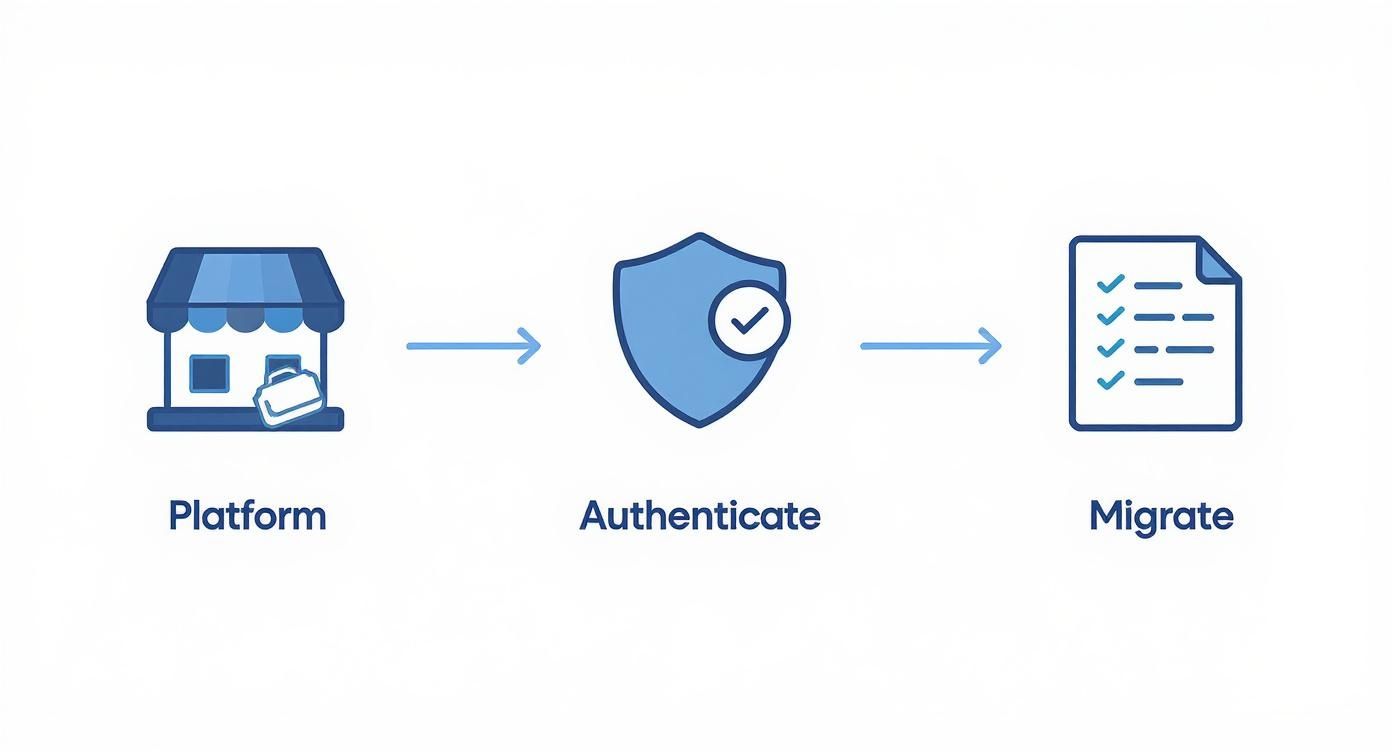
This simple flow—connecting your platform, getting your domain authenticated, and moving your list over—is the launchpad for every profitable automation you'll create.
The Welcome Series That Converts Subscribers Into Customers
You only get one shot at a first impression, and your welcome series is it. The moment someone hands over their email address, their interest in your brand is at its absolute peak. Your job is to jump on that opportunity right away.
A huge mistake I see all the time is sending a single, lonely "Thanks for signing up" email. That’s not enough. A proper welcome series nurtures that brand-new relationship over a few days, gently guiding the subscriber toward making their first purchase.
Here’s a simple, proven three-email cadence that just works:
- Email 1 (Sent Immediately): Deliver the goods. This email needs to land in their inbox within minutes, delivering whatever discount or offer you promised. Keep it dead simple and focused on getting them to place that first order.
- Email 2 (Sent 24 Hours Later): Tell your story. Why did you start this business? What makes your products different? This email builds a human connection that goes way beyond a simple transaction.
- Email 3 (Sent 48 Hours Later): Unleash the social proof. Show off your best-selling products right next to glowing customer reviews or user-generated content. This builds a ton of trust and helps new subscribers see what everyone else already loves about your brand.
This sequence is so effective because it methodically builds trust. It starts with an immediate reward, follows up with brand storytelling, and closes with social validation—a powerful trio for turning fresh leads into paying customers.
The Abandoned Cart Flow That Recovers Lost Revenue
If you only have time to build one automation, make it this one. It’s a non-negotiable. People abandon carts for a million different reasons—the dog started barking, they got sticker shock from shipping costs, or they just got distracted. Your abandoned cart flow is the safety net that brings these high-intent shoppers back to finish what they started.
The financial impact here is massive. On average, abandoned cart flows can pull in a revenue per recipient (RPR) of $3.65. Compare that to the measly $0.11 RPR for a standard promotional email, and you'll see why it's a no-brainer. It's no surprise that 54.2% of all ecommerce automations are for cart abandonment—it's just that critical. You can dig into more of these numbers in these email automation findings on Klaviyo's blog.
Pro Tip: Don't just send one reminder and call it a day. A multi-email sequence is way more effective. Try testing different angles: a gentle nudge, a message highlighting product benefits, and maybe a small discount in the final email to seal the deal.
Here’s a sequence that consistently pulls in sales:
- Email 1 (Sent 1-2 Hours After Abandonment): The Gentle Nudge. This is just a friendly, low-pressure reminder. "Did you forget something?" Make sure to include big, clear images of the items in their cart and a direct link straight back to checkout.
- Email 2 (Sent 24 Hours Later): Overcome Their Objections. Use this email to remind them why they should buy from you. Talk about your free shipping, easy return policy, or drop in a few customer testimonials to calm any lingering doubts.
- Email 3 (Sent 48-72 Hours Later): Create Urgency with an Offer. This is your last shot. A small, time-sensitive discount, like 10% off for the next 24 hours, can be incredibly persuasive for pushing those on-the-fence shoppers to finally click "buy."
The Post-Purchase Follow-Up That Creates Loyal Fans
The customer's journey is far from over once they click "confirm order." In fact, the post-purchase window is your golden opportunity to turn a one-time buyer into a repeat customer and, eventually, a true brand advocate. This is where you lock in the relationship.
A solid post-purchase flow does more than just send a receipt. It delivers real value, makes customers feel like part of a community, and keeps your brand top-of-mind for their next purchase.
Try building out a structure like this:
- Order & Shipping Confirmations (Immediate): These are transactional, yes, but they should still sound like your brand. They offer peace of mind and set clear expectations for when their goodies will arrive.
- Product Education (3-5 Days Post-Delivery): Help them get the most out of what they just bought. If you sell skincare, send a guide on "How to Use Your New Serum." If it's coffee, share a brewing guide. This simple step adds value and shows you care about their experience.
- Review Request (7-14 Days Post-Delivery): Ask for their thoughts while the product is still fresh in their mind. Authentic reviews are pure marketing gold, so make it incredibly easy for them to leave one with a direct link.
By setting up these three core workflows—welcome, abandoned cart, and post-purchase—you create a powerful, automated system that engages customers at every key moment, maximizing both immediate sales and long-term loyalty.
Unlocking Hyper-Personalization with Smart Segmentation
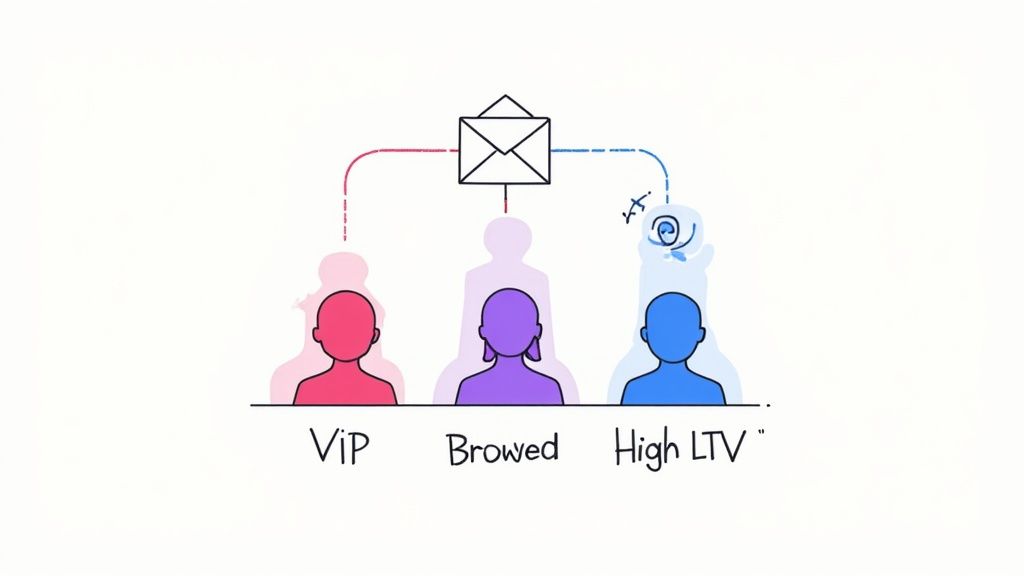
The days of blasting the same promo email to your entire list are well and truly over. If your money-making workflows are the engine of your ecommerce email marketing automation, then smart segmentation is the high-octane fuel that makes it roar.
Real personalization goes way beyond just slotting in someone's first name. It's about making every single message feel like it was written specifically for them.
This kind of relevance is impossible if you see your audience as one giant blob. You have to start thinking of them as a collection of individuals, each with their own unique habits, tastes, and history with your brand. Segmentation is simply the art of sorting these individuals into meaningful groups so you can hit them with incredibly precise, automated messages.
Moving Beyond Basic Demographics
When most people hear "segmentation," their minds jump to the basics like age or location. While that stuff has its place, the real magic for any ecommerce store lies in behavioral segmentation. This is all about grouping customers based on the actions they take—or don't take—on your site.
Think about it. Knowing a customer lives in California is one thing. Knowing they’ve bought three specific products in the last six months, browsed your new collection twice this week, and have a lifetime value over $500? That’s a whole different ballgame. This is the kind of data that powers truly effective automation.
Here are the most valuable behavioral segments you should be building:
- Purchase History: Group customers by the products or categories they’ve actually bought. Someone who only buys running shoes probably doesn't care about your new line of hiking boots.
- Purchase Frequency: You need to talk to your one-time buyers very differently than your loyal, repeat customers. Split them up.
- Average Order Value (AOV): Create buckets for low, medium, and high spenders. This is how you identify and reward your best customers with exclusive offers.
- Browsing Behavior: This is a goldmine. Track customers who view specific products but don't add to cart or buy. It's the perfect trigger for a personalized follow-up.
By focusing on what customers do, you build segments that mirror their interests and intent. Your automated emails instantly become more relevant and far more likely to convert.
The Power of Dynamic Segments
The best part about modern email platforms is the ability to create dynamic segments. Unlike a static list you have to constantly update by hand, a dynamic segment updates itself automatically, in real-time. You just set the rules and let the system do the heavy lifting.
For example, you could create a "VIP Customer" segment with a simple rule: "Customer has spent more than $1,000 total." The second a customer crosses that spending threshold, they’re automatically pulled into the VIP segment and can be dropped into an exclusive thank-you workflow.
Key Insight: Dynamic segments turn your email list into a living system. Customers flow in and out of different groups based on their latest actions, ensuring every automated message they get is perfectly timed and contextually aware.
This is what unlocks hyper-personalization at scale. You can automatically trigger a re-engagement campaign the moment a customer hits 90 days without a purchase, or send a cross-sell offer a week after they buy a complementary product. It’s all hands-off.
Putting Segmentation into Action
Let’s walk through a real-world scenario. Imagine a skincare brand launching a new high-end, anti-aging serum. Instead of sending a generic "20% Off Everything" email blast, they use sharp segmentation to create three distinct, automated campaigns.
Scenario: A New Product Launch for an Advanced Anti-Aging Serum
Segment 1: The VIPs
- Criteria: Customers who have spent over $500 and previously purchased from the anti-aging category.
- Automated Message: This group gets an exclusive "early access" email 24 hours before anyone else. The message thanks them for their loyalty and frames the new serum as a perfect next step in their routine. It makes them feel special and appreciated.
Segment 2: The Hesitant Shoppers
- Criteria: Customers who viewed the new serum's product page more than once but didn’t buy.
- Automated Message: Two days after the launch, this segment receives an email packed with education and social proof. It might link to a blog post detailing the key ingredients and feature glowing reviews from early adopters. The goal is to build trust and nudge them over the finish line.
Segment 3: The Lapsed Customers
- Criteria: Customers who have purchased before but have been inactive for over 120 days.
- Automated Message: This group gets a "We Miss You" offer. It might bundle the new serum with a proven bestseller for a special price. Here, the goal isn't just to sell the new product; it's to win back an old customer with an irresistible deal.
- Predictive Send Times: Forget sending emails at a generic "best time." AI can look at each subscriber's personal open history and predict the exact hour they're most likely to check their email and engage.
- Churn Prediction: AI models can flag customers who are at high risk of churning based on subtle drops in engagement. This lets you automatically enroll them in a targeted win-back campaign before you lose them for good.
- Predictive Product Recommendations: This goes way beyond showing "products you also viewed." AI can actually anticipate what a customer might want next by analyzing the buying habits of thousands of similar shoppers, creating a truly personal shopping experience right in their inbox.
- Check for Native AI Tools: First, poke around your current email platform. Look for anything labeled "AI subject line generator," "predictive sending," or "AI copy assistant." The easiest way to start is to just try one of these features in your very next campaign.
- A/B Test Everything: Don't just take the AI's word for it. Put its suggestions to the test against your own ideas. Run A/B tests on subject lines, body copy, and send times to see what actually resonates with your audience.
- Turn On AI Recommendations: If your platform has it, enable AI-powered product recommendation blocks in your emails. They are particularly effective in post-purchase follow-ups and cross-sell automations. Keep a close eye on your click-through and conversion rates to measure the impact.
- Conversion Rate: This is the big one. Of the people who got an email from a specific flow, what percentage actually bought something? This tells you exactly how well your automation is doing its main job: driving sales.
- Revenue Per Recipient (RPR): This metric puts a clear dollar value on every single email in a sequence. It’s a fantastic way to quickly compare the financial punch of different automations, like seeing if your welcome series is out-earning your abandoned cart flow.
- List Churn Rate: Are people sprinting for the unsubscribe button when they enter a certain automation? If you see a spike in unsubscribes, your workflow might be too aggressive, potentially burning bridges with customers you want to keep around.
- Subject Lines: This is your first impression and your only shot to get the email opened. Pit a straightforward subject line ("Your Cart is Waiting") against one that drums up a little urgency ("Your Items are Selling Out!").
- Calls to Action (CTAs): The text and look of your main button can make a surprising difference. Test something simple like "Shop Now" against a more direct "Complete Your Order," or see if a different button color catches more eyes.
- Offers and Incentives: For flows like abandoned cart or customer win-back, the offer is the star of the show. See what motivates more people to pull the trigger: a 10% discount or free shipping?
- Birthday Automations: A simple "Happy Birthday" email with a small, exclusive gift can make a customer feel genuinely special.
- Replenishment Reminders: Selling consumables like coffee or skincare? Automatically remind customers to reorder before they run out. It's helpful, not pushy.
- Feedback Requests: A couple of weeks after a purchase, send an email asking for their honest opinion. This gives you valuable social proof and shows you actually care about their experience.
Each of these messages is infinitely more powerful than a one-size-fits-all email. By layering behavioral data, the brand makes sure every subscriber gets an offer that speaks directly to their personal relationship with the company. This is how you turn a simple email list into your most powerful revenue-generating asset.
Using AI to Supercharge Your Email Strategy
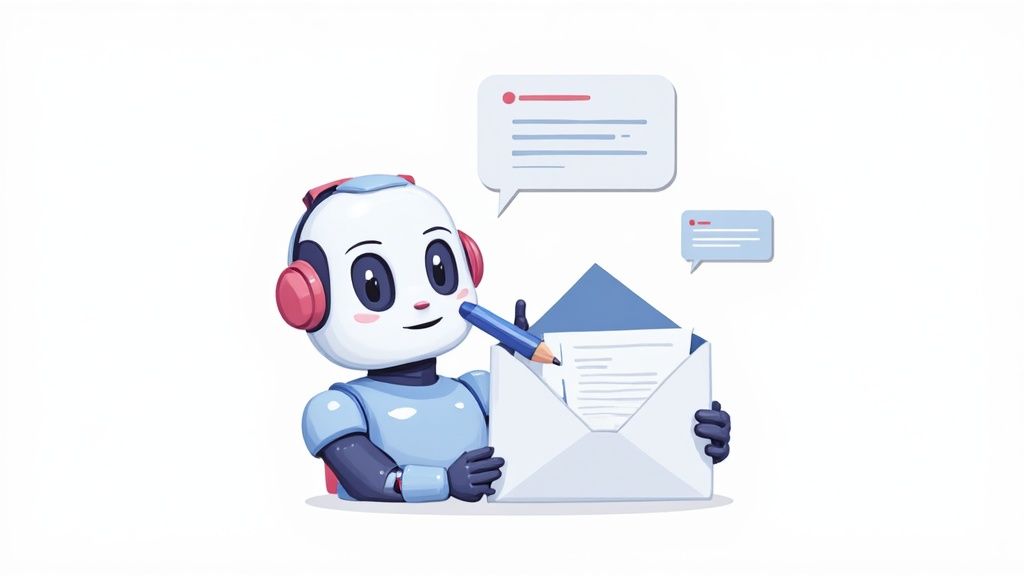
Artificial intelligence isn't some far-off concept anymore. It's a real, powerful tool you can use right now to get a serious edge in the inbox. Weaving AI into your ecommerce email marketing automation is like giving your entire strategy a brain—one that can learn, predict, and adapt in ways that a manual setup just can't keep up with.
Think of AI as your new secret weapon. It can take over the tedious parts of content creation and crunching the data, freeing you up to think about the bigger picture. It’s not about replacing the human element, but making it smarter, faster, and a whole lot more effective.
From Writer’s Block to High-Converting Copy
Let's be honest, we've all stared at a blank screen wondering what to write. This is where AI makes an immediate impact. Many of the big email platforms now have AI assistants baked right in, ready to generate compelling subject lines, preview text, or even the entire email body from a simple prompt.
Need an abandoned cart email? Instead of brainstorming from scratch, you can tell the AI: "Write a friendly but persuasive email to win back a cart, and make sure to mention our free shipping and easy returns." In seconds, you'll have several solid options ready to test. It's no surprise that 34% of marketers are already using generative AI to create their email copy.
If you want to get a better handle on the tech that makes this possible, it's worth getting a deeper understanding of generative AI.
Predictive Analytics for Perfect Timing and Offers
Beyond just writing, AI is a powerhouse when it comes to predictive analytics. It can sift through massive amounts of customer data, spotting patterns you'd never see on your own. This completely changes the game for your automated flows.
The results speak for themselves. AI-driven strategies have been shown to deliver a 13% increase in click-through rates and an incredible 41% jump in revenue compared to old-school methods. When you let the algorithms sweat the small stuff, you unlock a new level of performance.
Getting Started with AI in Your Email Platform
Putting these powerful tools to work is probably easier than you think. Most of the top ecommerce email platforms are already building AI features directly into their product.
By carefully adding these AI tools into your workflow, you can turn your email automation from a simple sequence of messages into an intelligent system that is constantly working to boost engagement and drive more sales.
How to Measure and Optimize Your Automations
Getting your automated workflows live is a huge win, but it’s really just the starting line. The brands that truly crush it with ecommerce email marketing automation treat their flows like a living, breathing system—one that needs regular check-ups to stay in top shape. This is where you separate the good from the great.
If you just set up an automation and walk away, you're absolutely leaving money on the table. Customer habits change, your product catalog evolves, and the strategy that worked six months ago might be dead in the water today. To turn your email program into a reliable revenue machine, you have to commit to consistent measurement and optimization.
Identifying the Metrics That Actually Matter
When you pop open your analytics dashboard, it's easy to get lost in a sea of data. To cut through the noise, you need to laser-focus on the key performance indicators (KPIs) that directly impact your bottom line. Vanity metrics like open rates are nice to look at, but they don't actually pay the bills.
Here are the core metrics you should be obsessing over:
Key Takeaway: Your time is best spent on metrics that track real money and customer loyalty. A high open rate is great, but a high RPR and a low churn rate are what build a sustainable business.
To get the full picture of your email program’s performance, you need to connect your efforts to financial outcomes. It’s worth taking the time to understand measuring your marketing ROI so you can see exactly what you're getting back from your investment.
The A/B Testing Framework for Continuous Improvement
Once you know what you're measuring, you can start making it better. A/B testing (or split testing) is your secret weapon here. It’s a straightforward way to compare two versions of an email to see which one performs better, letting data—not guesswork—guide your decisions.
The golden rule is to test just one thing at a time. If you change the subject line, the CTA button, and the main hero image all at once, you'll have no earthly idea which change actually moved the needle.
Start by testing the elements that have the biggest potential impact first:
It also helps to know where you stand. Understanding how your numbers compare to industry averages gives you the context you need to set realistic goals. For a better sense of what's possible, check out our guide on current email marketing benchmarks.
Interpreting Data and Finding New Opportunities
The data tells a story; you just have to learn its language. For example, did you know that automated flows have an average open rate of 48.57%, with the best performers hitting nearly 66%? Even more impressive, these automations can pull in up to 30 times more revenue per recipient than your standard one-off campaigns. That's the power of optimization.
Look for patterns in your own data. If you see a massive drop-off after the second email in your welcome series, that’s a huge red flag. Something in that email is turning people away. That's your cue to dig in, form a hypothesis about what’s going wrong, and start A/B testing a fix. Optimization isn't a one-and-done task—it’s a cycle: analyze, hypothesize, test, and repeat.
Common Questions About Email Automation
Even with a solid game plan, questions always pop up when you start digging into ecommerce email marketing automation. Getting straight answers helps you feel more confident and keeps your strategy from going off the rails. Here are some of the most common questions we hear from store owners just like you.
How Many Emails Should Be in a Welcome Series?
A great starting point is three to five emails spread out over the first week. The first one has to go out immediately to deliver whatever discount or freebie you promised for signing up. You want to capitalize on that initial moment of excitement when a subscriber is most engaged.
After that first message, you can ease them into your brand. Send an email introducing your story, show off some of your best-selling products, and maybe sprinkle in a few authentic customer reviews. The goal here is to build trust and nudge them toward that crucial first purchase without completely overwhelming their inbox.
Which Automation Should I Build First?
Always, always start with the abandoned cart workflow. It’s the single highest-impact automation you can build and will give you the fastest return on your time.
This workflow targets shoppers who were this close to buying, having already added products to their cart. Turning this on means you can start recovering what would have been lost revenue within hours. It's easily the most profitable first step you can take.
What Is the Biggest Mistake People Make with Automation?
The most common trap is treating automation as a "set it and forget it" tool. It just doesn't work that way. Your customers' behaviors change, your product catalog evolves, and what worked six months ago might be completely ineffective today. Automation needs ongoing attention to stay sharp.
Make it a habit to check in on your automation performance at least quarterly. If you notice a workflow's revenue per recipient has dropped off a cliff, that's your cue. It’s a clear sign that the offers, copy, or product recommendations inside are stale and need a refresh to stay relevant.
Can I Use Automation for Anything Besides Direct Sales?
Absolutely. While recovering carts and welcoming new subscribers are massive for sales, automation is also an incredibly powerful tool for building long-term customer loyalty and boosting lifetime value.
Think about setting up workflows for non-salesy touchpoints that make your customers feel seen and appreciated.
These kinds of relationship-building automations are what turn one-time buyers into loyal fans who stick around.
Ready to turn your email list into a revenue-generating machine? The team at ECORN are Shopify experts who specialize in designing and optimizing high-converting email automation strategies. Let's build a system that works for you, so you can focus on growing your brand. Schedule your free consultation today!






